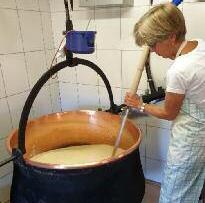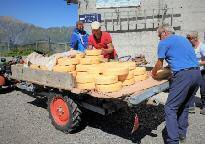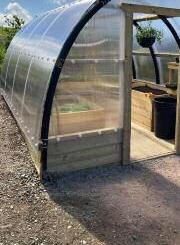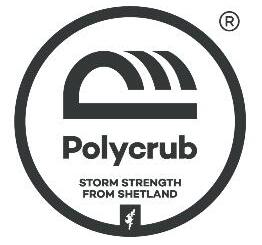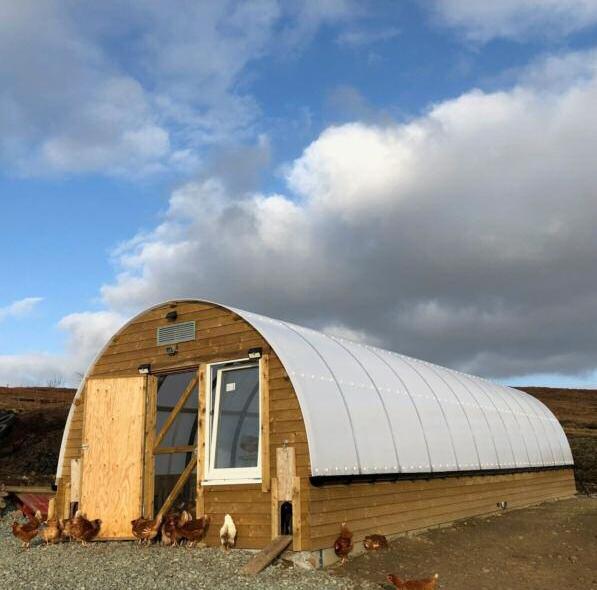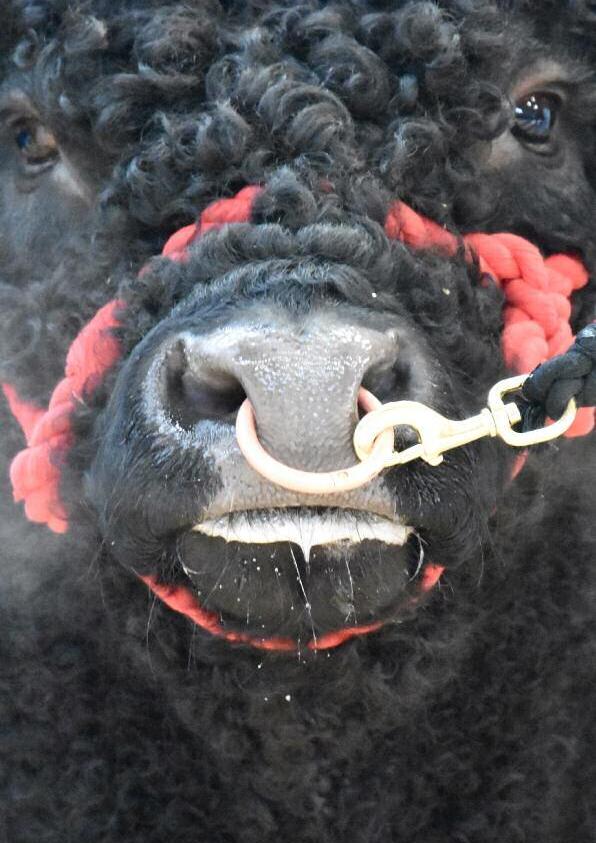
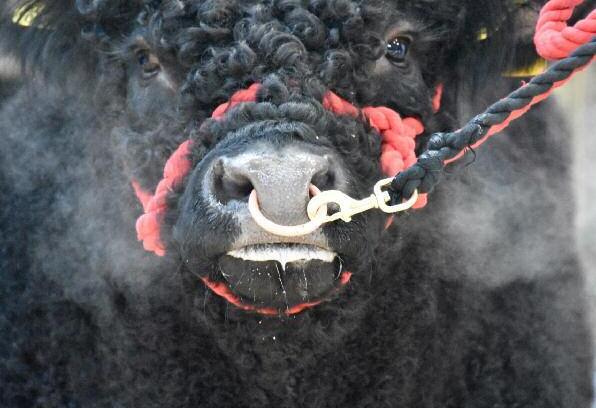
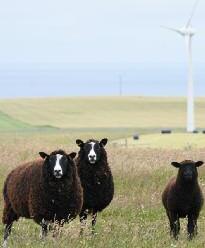
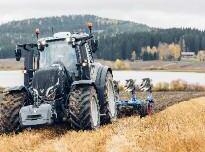
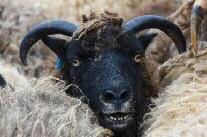
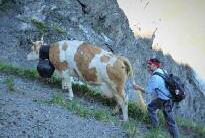
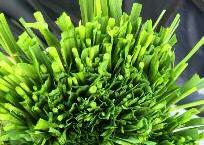
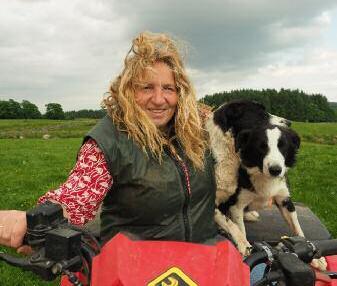









t has been a tumultus time with war raging in Ukraine and it is having a knock on effect across the board, with soaring fuel and feed prices.
Our machinery guru Chris McCullough, who is married to a Urkrainian, has written a feature on how one crop farmer is coping with sowing this years crops with virtually no back up
We have a new columnist, Perthshire regenerative beef, sheep and Organic free-range egg producer, Alex Brewster He farms over 1000ha of upland grazing and took out Soil Farmer of the year 2020 He is also a Nuffield Scholar and Director of Powered Pasture Ltd Enthusiastic about all things soil,
microbiology and mob grazing.
Regular writer, James MacLean is expanding again. Please note both columnists wrote their script before the hike in feed prices took place
Nineteen Scots have been given the honour to judge at Balmoral Show this year - see pages 42
A trip to the island of North Ronaldsay, Orkney, last summer was the highlight of our Orcadian trip Read all about it from page 46
Petra Jacob followed an Alpine transhumance in Switzerland on pages 52-55
Lambing is upon us so I better get round the fields once more
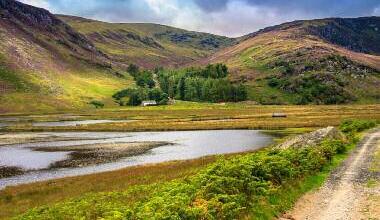
Anew policy briefing has called for transformative change in the planning and management of designated protected land in Scotland
The Scottish Government has set out its intent to protect at least 30 per cent of Scottish land – with 20 per cent of this already designated
The briefing, by Scotland's Rural College (SRUC), says collaborative management of protected areas helps to deliver more than just local benefits, by contributing to UN Sustainable Development Goals
These include improving health and
wellbeing, and conserving, protecting and sustainably using marine and terrestrial resources to halt degradation and biodiversity loss
Currently, there is a network of 5389 designated marine and terrestrial natural features across Scotland on public, private, or community-owned land.
During the Covid-19 pandemic, visiting areas of natural beauty and observing wildlife became sources of wellbeing and cultural significance
In the briefing, researchers at SRUC's Rural Policy Centre say now is the time
to capitalise on the public's enhanced appreciation of green spaces by engaging them in decisions about where the next 10 per cent of protected areas should be designated
And they suggest creating more local place-based partnerships to help establish and manage these new protected areas
The report highlights Lunan Lochs Natural Care Scheme and Cairngorms Connect as two examples of how collaboratively managed protected areas can help Scotland achieve wider sustainability goals
Alexa Green, Trainee Research Assistant at SRUC and co-author of the report, said: "Considering the biodiversity and climate crises and following the Covid-19 pandemic, radical transformative change is needed in the ways we govern and plan for protected areas.
"Now is a good time to tap into heightened awareness of the importance of local greenspace with high nature value and engage the public in identifying how to best manage protected areas for shared benefits "
The policy spotlight was produced with the support of Scottish Funding Council with Universities Innovation Fund funding
Moredun, in collaboration with the University of São Paulo, UKRI and FAPESP, have released a new and exciting short animation in their entertaining animation series to help inform and educate people about a parasite called Toxoplasma gondii.
Tackling Toxoplasmosis is a fun and engaging animation describing the life cycle, transmission routes and control options for a tiny parasite of huge veterinary and public health importance and it has been described as the world's most successful parasite
The animation was developed as part of a research project funded by BBSRC (UKRI) and FAPESP (São Paulo Research Foundation, Brazil) looking at differences in virulence in Toxoplasma strains
Toxoplasma gondii is widespread and can infect all warm-blooded animals, yet many people have never heard of it and do not know how it is spread The parasite is shed in the faeces of cats and can cause abortion in sheep, leading to economic losses for
farmers and is also a public health problem as it can be transmitted to people through undercooked infected meat and contaminated water In some parts of the world, such as South America, strains of the parasite can cause severe disease, even in healthy people.
Although it is a widespread parasite, there are ways to control and prevent infection in people and animals. Education is key and this animation outlines the control options available for farmers to prevent infection in their livestock and for people to avoid infection from contaminated food or water
Created by the very talented team at Ping Creates, led by Selina Wagner, this animation, which is available in English and Portuguese, simplifies the complex life cycle of Toxoplasma and describes the different ways to prevent infection It also highlights the current research on Toxoplasma being undertaken by scientists at Moredun and the University of São Paulo.
Dr. Clare Hamilton, Project Lead on
BBSRC-FAPESP grant: "We really enjoyed working with Selina and her team and they have done a superb job creating a fun and engaging animation The life cycle and transmission routes of Toxoplasma can be quite complicated, but the animation makes it easy to follow and gets all the key points across. It is a fantastic educational resource for us to share with farmers, stakeholders, and members of the public, both in the UK and Brazil ”
Dr Hilda Fátima Jesus Pena, Principal Scientist at University of São Paulo, and Co-Investigator on BBSRC-FAPESP grant: "Toxoplasmosis occurs widely in Brazil and the video will be an incredible educational tool for different audiences (it is clear, light in tone and thoroughly informative) We hope it will increase awareness regarding this significant disease "
This animation was funded by UKRI, FAPESP (grant #2019/21697-6) and the Moredun Foundation and can be found on: https://moredun org uk/resources/videos/tackling toxoplasmosis
Sheep CT scans could be analysed at lightning speed using machine learning, according to a new study
Dr James Robson, a researcher at Scotland’s Rural College (SRUC), used a deep neural network – a collection of mathematical artificial neurones designed to mimic a brain – to instantly perform the image editing steps, such as removal of the cradle which sheep are scanned in, and computer vision to quickly extract key information at a speed of 0.11 seconds per CT scan.
The results of the study, published in a special edition of Sensors, showcase how machine learning could be used to help guide genetic improvement programmes and aid detection of invisible diseases
The image processing model was trained on CT scans already routinely collected by SRUC’s CT scanning team and using an NVIDIA DGX Station containing over 20 000 cores This allowed new unseen images to be processed using machine learning with
an accuracy of 98 per cent compared to those produced manually
Important traits such as muscle or fat percentage and length or width of limbs, which are typically measured from the image by hand, were then calculated automatically
Dr Robson said: “This tool not only saves a lot of time but allows us to process far more data than before and gather information, which can then be used to guide genetic breeding programmes.
“It’s really amazing to see the wide variety of challenges that machine learning can be used to address We are hoping to expand this research into other areas and invite any organisation to come forward if they have image or video datasets they think might contain something of interest ”
If you would like to engage with SRUC in developing novel agricultural tools powered by machine learning, please email james robson@sruc ac uk

Anew annual prize has been created by SAC Consulting –part of Scotland's Rural College (SRUC) – in memory of Senior Consultant Gavin Elrick
Gavin, who was part of SAC Consulting's Environment Team, helped Scottish agriculture become more sustainable by sharing his vast knowledge with farmers and crofters across the country His untimely death in November 2020 came as a shock to colleagues and the wider rural community
The inaugural Elrick Prize has been awarded to Consultant Alex Pirie in recognition of his work to improve the sustainability of land use.
Alex, who is from a dairy farming background near Campbeltown, is
already well regarded across the business and with many farming stakeholders
He was nominated by Principal Consultant Chloe McCulloch and seconded by Regional Development Manager Raymond Crerar
Chloe said: "The work Alex has done in supporting the Net Zero Arran group has been inspiring His ability to attract influential stakeholders and policy makers and explain the impact of the group will increase the opportunities for others to participate in this type of activity in future.
"He should also be recognised for his work with the Agri Environment Climate Scheme. He brings a genuine enthusiasm, coupled with creativity and significant skill and I am in no doubt
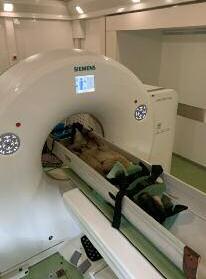
there are sustainable management activities that are only happening today because Alex stepped forward to take on a really challenging job in designing and delivering a fundable application
"Finally, on a personal note, Gavin may have been employed by SRUC as a consultant, but he was also an advisor of the old stamp, motivated by supporting farmers, friends and colleagues and his industry I see similar qualities in Alex and therefore this nomination is truly fitting "
Alex said: "I am absolutely delighted and honoured to be nominated for the first Elrick Prize.
"It is a superb way to recognise Gavin's outstanding contribution to the industry and the way in which he conducted himself "

The Aberdeen-Angus breed has come out top in the BCMS 2021 registration results
With 471 528 registrations across the year, Robert Gilchrist, CEO of The Aberdeen-Angus Cattle Society says, it is fantastic to be leading the way when it comes to beef production
“Having the largest membership of any UK beef breed society, topping the BCMS table is something we ’ ve had our sights set on for the last few years and are pleased to have now achieved this,” says Mr Gilchrist
He believes the latest figures, which show a 4 5% growth in market share since 2018, taking Aberdeen-Angus to 24 41%, is as a result of the on-going promotion of the breed coupled with a
Apopular coastal path in Strathaird on the Isle of Skye, provided an ideal opportunity to try a sustainable technique that uses locally-sourced materials
The Kilmarie path is well used by the community, as well as people visiting the Iron Age fort at Dùn Ringill, and a 100-metre section had become very muddy where it crosses deep peat
Trust Skye team member John MacRae - who is also a local crofter –repaired most of the section using gravel from a nearby quarry on top of sheep wool to hold the gravel in place He completed the remainder using gravel on a traditional plastic membrane as a
changing beef and dairy supply chain that sees the value that native breeds have to play
“It’s widely documented that British agriculture is facing the biggest changes and challenges in over 50 years, ” he notes “Farmers are being met with a reduction of BPS payments alongside mounting consumer pressure to produce sustainable beef that benefits the environment.
“This has brought into focus for farmers more than ever, the need to have an efficient and viable business, and much of this is down to genetics and the breed they focus on to meet the market demands of today’s consumers ”
“The Society has been promoting the benefits of the breed to beef producers in
comparison
John sourced fleeces from local crofts including from his own flock, ensuring he followed the guidelines, which state that the wool must be sourced as locally as possible, as well as being in its raw state and unprocessed, to avoid introducing contaminants
For the repair, he dug a trench to hold the new surface – as he would for a regular path - but, rather than lining it all with geotextile matting, he lined 80 metres with wool. This was rolled up or folded to create a "floating path" that was then covered with stones The wool will (hopefully) prevent the stones from sinking into the bog
terms of sustainability for some years and we ’ re now starting to reap the rewards in terms of the number of Aberdeen-Angus cattle registered within the UK
“We have a beef herd book to be proud of but there is also major opportunity within the dairy sector for our Aberdeen-angus genetics. Traits such as easy calving, high calf vigour and low input finishing are attractive qualities that can help ensure every calf is reared to suit dairy systems but with the end beef market in focus ”
There is no doubt that with an increasing focus on business viability and sustainability credentials, AA will continue to be the number one breed able to produce beef fit for the future
John learned a lot about the process as he worked on the repair between February's storms He said: “The weather was truly shocking for the majority of the job, which also highlights the fact that wool can be used in very wet conditions
“I used 300 fleeces in a 80 metre section For the remainder I used non-woven geo-textile matting as a comparison for the trial
“Feedback from the community and the crofter who supplied most of the fleeces has been brilliant. In fact the crofter visited the site several times throughout the repairs and gave it 10 out of 10 when it was completed ”

The Crofting Commission has soft launched a new online service, which will allow Crofters, or their Solicitors and Agents, to make some regulatory applications digitally.
At present the service will cover Assignation Applications as well as Subletting Applications, with more application types planned to be made available over the coming months
Malcolm Mathieson, Convenor of the Crofting Commission said: “Making processes as accessible and streamlined as possible is a priority for us as the regulatory body for Crofting The new process will make the application process more simple for Crofters and their Agents and help to ensure we get all the needed information first time Our new services are being soft launched to ensure that professional bodies as well as Crofters are introduced to our new service in a secure way. ”
“Its important to stress that Crofters and their agents can still use existing paper application pathways, these will still be available for download from our website; but we would encourage everyone to take advantage of the new service that we are providing The digital application service will continue to expand over the coming months and will incorporate many more application types ”
“At present Assignations and Lettings will only be available to apply for digitally by Solicitors and Agents, in order to protect Crofters and their identity interests; but we hope to expand this soon with extra verification processes ”
“The regulatory process can take a considerable length of time in some circumstances due to the legal processes that are involved with land transactions. We hope that the introduction of digital applications in addition to the increased number of administration staff will help to make the application process more efficient for Crofters ”
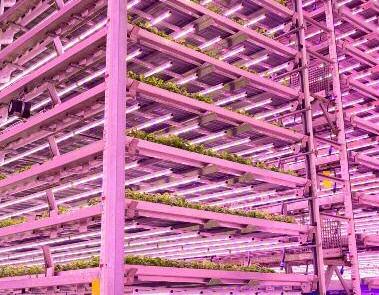
Scotland’s Rural College (SRUC) is investing in a vertical farm, a series of online tech training films is now available to explain the exciting range of innovative technology being used in the sector
Vertical farming, machine learning, drones and blockchain technology are just some of the topics explored in SRUCBytes, eight episodes of which can now be viewed on the SRUC website.
Dr Hannah Rudman, Senior Challenge Research Fellow at SRUC, who has created the training sessions supported by colleagues at SAC Consulting, said: “We all love to talk about digital technologies as easier, better, faster ways to do things
“SRUCBytes episodes provide an explanation of the basics of the tech and
Page 4 – SRUC
Page 5 – SRUC
Page 6 – Provided
Page 6 – John Muir Trust
Page 7 – SRUC
Page 8 – RHASS
Page 9 – RHET
Page 11 – SRUC
Page 13/15 – James MacLean
Page 18 – Jane Brewster
Page 22 – AA Cattle Society
Page 28 – Lallemand Animal N
give us insight into how new tech is actually being deployed in the natural economy sector and the real benefits it achieves
“Tech training around new technologies is important for everyone, as digital transformation introduces it more into our everyday work and lives ”
The technology explanations will give people insight into what they actually do and how they do it, with episodes showcasing how it is being deployed in the natural economy sector and the real benefits it achieves
SRUCBytes was funded by a Universities Innovation Fund grant to SRUC, provided by the Scottish Funding Council
Page 29 – AHDB
Page 30 – Provided
Page 31 – Lemken
Page 32 – Pottinger
Page 34 – Agco
Page 35 – New Holland
Page 36 – Horsch/Michelin/Lemken
Page 38 – Valtra
Page 40 – Massey Ferguson
Page 44/45 – Provided
Page 52/55 – Petra Jacob
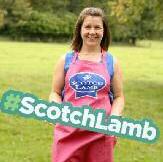


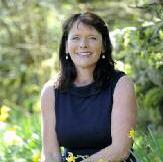
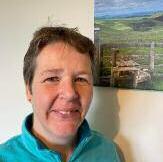
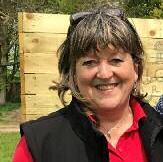
The RHASS has awarded funding for six candidates to attend the Women in Food & Agriculture Summit Taking place in Frankfurt, Germany from 14-15 June 2022, the funding will provide the opportunity for the chosen candidates to network and learn from other women working across the worldwide food and agricultural sector
The candidates went through an application process to outline how the Summit will benefit them and the sector They will report back upon their return detailing key outcomes and actions, which will support their business and the wider sector
The successful candidates are:
Alix Ritchie – Alix farms in Perthshire with husband John and is Health & Education Manager for QMS, being passionate about educating the public about where their food comes from. Previously, Alix was a Project Coordinator for Perth & Kinross Royal Highland Education Trust (RHET) and has also worked for Scottish Association of Young Farmers Clubs (SAYFC) as East Regional Coordinator
Judith Taylor – Judith runs a mixed farm in partnership with her father near Turriff in Aberdeenshire After studying agriculture at Aberdeen University and working for a short time at SGRPID, Judith set up her own farm consultancy
business and still has a small number of customers she helps with book keeping and keeping cattle records Judith also attended the Women In Agriculture 'Be Your Best Self' pilot course just before the first lockdown in 2020.
Chloe Stewart – Chloe is a 22 year old 6th generation (3rd generation female) crofter from Gills, Caithness Having graduated with a BSc (Hons) in Agriculture last year, Chloe is excited to learn more about what can be done to help the crofting community be more sustainable and efficient
Heather Wildman – Originally from Cumbria, Heather has lived in Scotland for over 21 years She runs her own business, Saviour Associates, which focuses on helping individuals and businesses identify their goals, mission, vision and values; how and who they can communicate this to; and how to build up the right team with the right skills to achieve and deliver this.
Lesley Mitchell – Lesley farms in partnership with her husband and son on their organic beef, venison and arable farm near Hawick She also works off the farm part time as a Quality Assurance Specialist with Quality Meat Scotland
Carole Brunton – lives with husband Ian at mixed sheep and arable Balmonth Farm in the East Neuk of Fife Working for RHET as Project Coordinator in Fife
for almost 20 years She is also on the Women in Agriculture Scotland Committee as well as being President of Fife & Kinross Young Farmers
RHASS Chairman, Bill Gray, said: "RHASS is delighted to offer this opportunity to the six successful candidates. The Summit will be an invaluable platform for them to connect with like-minded individuals from across the globe, share best practice and be inspired
"We are confident they will return from the Summit with fresh ideas to benefit their organisations, businesses and the sector as a whole in Scotland and look forward to hearing all about their experiences "
Susan Lawrie, Chair of the RHASS Public Relations & Education committee, commented: "The calibre of applicants was inspiring and those who were selected represent a great mix of different agricultural backgrounds from all over Scotland.”
Successful candidate Judith Taylor said: "I was absolutely delighted to be selected by RHASS to attend the WFA Summit I cannot wait to go to Germany in June, thank you to RHASS for giving me this amazing opportunity "
You can find out more about the awards & grants RHASS offers here: https://rhass.org.uk/awards-and-grants/
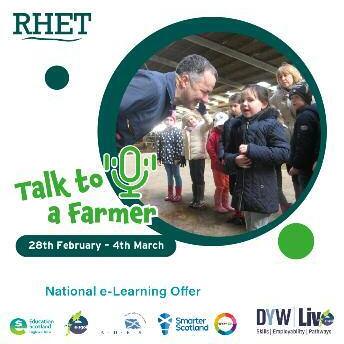
During the first week of March, 20 000 Scottish school pupils were given the chance to ask farmers how they produce food and look after their animals
This phenomenal interaction was all thanks to the Royal Highland Education Trust (RHET), in partnership with e-Sgoil, who delivered the 'Talk to A Farmer' programme of sessions via the DYW (Developing the Young Workforce) Live platform
Talk to a Farmer was the brainchild of RHET, whose role is to enable more school children across Scotland to learn about food, the countryside and farming The best way to achieve that is to allow children to interact directly with farmers, either on farm visits or via virtual platforms and events such as Talk to a Farmer
The 27 volunteer farmers involved all come from RHET areas across Scotland, from Donald Ross in the Highlands to Alistair Hodge near Duns in the Scottish Borders School pupils tuned in to ask questions of beef, sheep and pig farmers, dairy and arable farmers growing cereals, using anaerobic
digestors to generate electricity and even planting pumpkins for Halloween
Mr Constable from Kirktonholme Primary passed on his thanks to RHET for the talks, saying 'all the children enjoyed learning where food comes from on farms. Great that the farmers were women and men and they learned what life is like on the farm '
Angela Mill of Shawsmill Farm, Auchtertool received more than one hundred questions, ranging from "How long is a cow pregnant for?" to "How do you help animals stay healthy?" and "How old is your farm?"
Angela commented: "The quality of the questions indicated that the schools had engaged well and were really interested in what we had to say. It's great to know what so many people are keen to learn more about what we do "
Katrina Barclay RHET's Executive Officer said: "We are delighted with not only the uptake from schools during each live session, but the feedback we are still receiving from teachers and the wider farming community on what an important and informative event RHET ran My thanks to all the farmers who
said 'Yes!' to our plea to help us run something new and innovative for our charitable work Although we are organising farm visits for schools, we appreciate logistics may prevent teachers getting out of school What better way than to bring the countryside to the classroom in such an interactive way! "
Mrs Lannagan from Cockburnspath Primary School said: "We loved the live farmer sessions They could not have come at a better time for us as we are studying a topic about where our food comes from, eating seasonally, local farming and sustainability
"It is a fun way to learn about farms and where our food comes from It is also really interesting to see how different farms work and to see how farms are working to help save the planet Watching the live streams are enjoyable as we can ask questions and the interactivity was the best point."
RHET plan to deliver more sessions using this platform and the sessions delivered during March are all available to view at https://e-sgoil com/farmersweek/
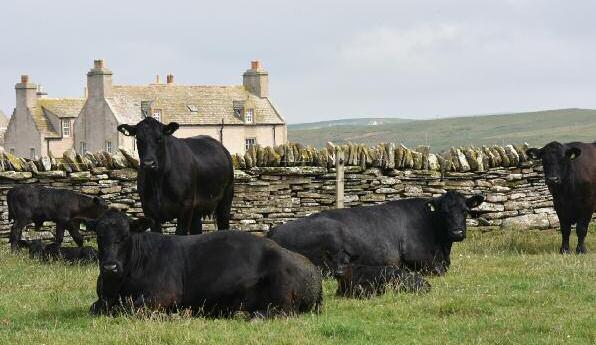
Cattle farmers on the Orkney Islands are celebrating the news that their herds have been declared free of Bovine Viral Diarrhoea (BVD)
The office of Scotland’s Chief Vet, Sheila Voas, has confirmed that Government records show the last Orkney animal infected with BVD, was removed on 4th March 2020 – resulting in Orkney being clear of BVD for two years
Widespread throughout the world, BVD is regarded by vets as the most significant cattle disease in Europe and North America
If the foetus of non-immune in calf females is infected, possible consequences include abortion, infertility, reduced milk yield and still-born or deformed calves
Live Persistently Infective (PI) calves are incurable super virus spreaders
The virus can also suppress the immune system of other cattle in the herd, reducing their resistance to numerous serious and costly health challenges.
Orkney’s 550 cattle farmers keep 28 000 breeding cows on 247 000 acres (100 000 ha), representing the highest density of beef cattle in Europe In addition, the 16 dairy herds make Orkney the largest dairy field north of
Stirling Cattle have long been an important cornerstone of the Orkney economy
Over 20 years ago, a small group of Orkney farmers, along with a local vet and the Scottish Agricultural College (SAC) veterinary laboratory in Thurso, designed a scheme to eradicate BVD from Orkney
By adapting the Cattle Health Certification Standards (CHeCS), they created a scheme which was workable within Orkney cattle systems
The Orkney Livestock Association (OLA), with the target of eradicating BVD, was launched 1st February 2001, with a financial kick start of £500 000 from Orkney Islands Council to cover laboratory costs of initial blood tests
In the first two years of the OLA scheme, a total of 378 PI cattle were identified and removed, significantly reducing the cycle of infection
By spring 2007, well over 80% of Orkney herds had achieved BVD Accredited Status (earned after two consecutive clear annual blood test screens) Herd health improvement was resulting in Orkney farmers rearing more and bigger calves from the same number of cows
Six years into the scheme, figures from the Orkney SAC office showed profits for some farms, had increased by
up to 30% since 2001 While on average herds were weaning between three and four extra calves a year – resulting in a total of 1500 to 2000 additional head of cattle per annum for the Orkney economy
Current OLA Chairman, David Scarth, who farms 100 commercial and 50 pedigree beef Shorthorn cows at Twatt Farm in Birsay on the west of the Orkney Mainland said: “the achievement of BVD Clear status is the result of a joint effort over more than two decades, not only by the cattle farmers and vets, but all involved in the Orkney cattle industry, for which we are very grateful”
“The letter we recently received from the Scottish Government confirming Orkney has been clear of BVD for two years, included praise for OLA ‘ s successful BVD control in Orkney, which ‘has served as a model for the rest of Scotland’s cattle keepers ’
“Orkney is proud to give assurance to our cattle buying customers, who travel across the Pentland Firth, that every beast on offer is definitely free of BVD.”
Mr Scarth added –“of course, we can’t be complacent, in the past we ’ ve learnt how easy it is to unintentionally re-introduce BVD, so strict bio-security and monitoring of any cattle brought into Orkney, will continue ”
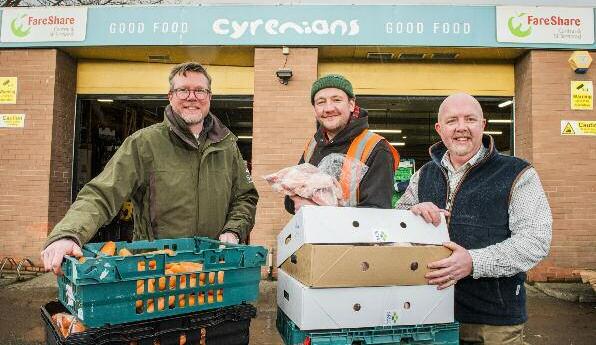
Nearly 156 000 meals were donated to more than 800 charities in 2021 using chicken supplied by Scotland's Rural College (SRUC) and poultry breeding company Aviagen®.
SRUC and Aviagen contributed 65.4 tonnes of chicken breasts and legs from their jointly owned poultry processing plant in Edinburgh to the UK food redistribution charity FareShare
The 832 charities receiving the 155 717 meals last year included those serving people on low incomes, clubs for school children, services for people experiencing homelessness, community groups serving older people and organisations for people with mental health conditions across the UK
SRUC and Aviagen are now in the process of becoming one of FareShare's Leading Food Partners – a scheme that recognises food businesses, which consistently divert their edible surplus food to charity and community groups, fighting food waste and reducing their carbon footprint.
As well as cutting down on food waste, the chicken donations saved the equivalent of 104 64 tonnes of CO2 and 9810000 litres of water
Andrea Whipp, Food Commercial Officer at FareShare, said: "We are facing even more challenging times ahead and to receive consistent donations of good quality chicken from SRUC and Aviagen
is invaluable
"Working with them has been a joy It is more than just providing surplus food They are genuinely interested in how the food helps and are looking for other ways to support FareShare."
Alina Donisa, from SRUC, said: "We are proud and grateful that we can play a part in the work that FareShare does, and it is wonderful to see the impact of the contributions made by SRUC and Aviagen
"Working with FareShare is a very straightforward and simple process and we would encourage other businesses to get involved
"Following the success of this partnership, we are considering further developments, such as employability schemes with partner charitable organisations "
Magnus Swalander, General Manager of Aviagen Ltd, said: "It is an honour to be able to give back to our local community in this way. Aviagen, SRUC and FareShare have a common commitment to sustainability, and we all work collaboratively to help feed the world, while doing our part to preserve our planet for future generations "
SRUC and Aviagen started donating chicken to FareShare at the beginning of the coronavirus pandemic in April 2020 to alleviate stock pressures caused by the closure of hospitality and food services during lockdown
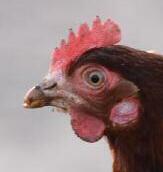
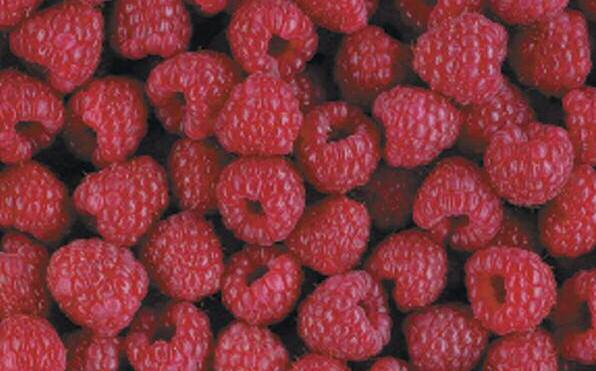
ata scientists at the University of Aberdeen are teaming up with fruit growers to build an artificial intelligence (AI) system to forecast harvests, which could potentially save the industry millions each year
The machine learning system for soft fruit yield forecasting is a three-year collaboration involving the University, Scotland's innovation centre for data and AI The Data Lab and Arbroath based Angus Soft Fruits Ltd
It aims to better harness key information such as historical yield and weather data, weather forecasts and satellite imaging and expert knowledge from growers, to develop algorithms that accurately forecast production and measure uncertainty.
With an estimated annual production of more than 2900 tonnes of raspberries and 25 000 tonnes of strawberries, inaccurate yield forecasting costs Scotland's fruit growers millions each year
The development of an intelligent and inexpensive forecasting system could prove crucial in ensuring profitability for growers, leading to more efficiencies in sales and packing and transport planning, while enhancing their reputation with customers and limiting food waste and associated carbon emissions
Georgios Leontidis, Director of the
University's Interdisciplinary Centre for Data and Artificial Intelligence, said: "We are delighted to team up with Angus Soft Fruits Ltd and The Data Lab in this exciting project that could prove to be a game-changer for an industry worth millions to Scotland's economy
"Over the three-year lifespan of this project we will work with growers to understand the flaws in current forecasting systems, develop advanced machine learning models that harness high quality data, and seek expert input from growers that can further enhance these models
"The ultimate aim is to produce an inexpensive yield forecasting system that brings all of this high-quality data together, providing maximum advantage for growers and helping them to stay in profit and protect jobs."
Jan Redpath, Technical Director of Angus Soft Fruits Ltd commented: "The berry market has matured in recent years and with it the margins have become much tighter Growers are therefore going out of the business of fruit production
"On the one hand we have soaring costs in particular labour and fertilisers, and on the other our biggest ability to influence price comes from being able to accurately match supply with demand, or at least to better pre-empt the scale and timing of flushes and dips in crop production
"Competitive advantage is gained from producing a stream of new varieties. However, with new varieties comes new crop results and there is no historical prediction data to rely on to forecast future yields
"Research into more accurate forecasting is required more than ever, and we are excited to work with the University and The Data Lab on what we see as a vitally important project, that has the potential to bring lasting benefits to our growers "
Heather Thomson, Head of Skills at The Data Lab, said: "Data is a hugely valuable and often untapped resource that, if used correctly, can help businesses improve processes and create much-needed efficiencies This project is just one of many different PhD and EngD studentships we fund through our Industrial Doctorates Programme, which is helping to digitally transform Scotland's economy.
"The farming sector is ripe for this type of digitally led transformation, with the ultimate aim of helping farmers increase yields whilst limiting waste and their impact on the environment It is more important than ever to better understand crop performance and increase competitiveness for commercial advantage AI will play a significant role in this and projects like this one will reinforce Scotland as a leader in implementing innovative AI solutions "


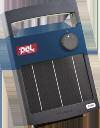
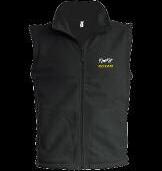

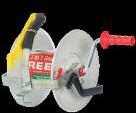




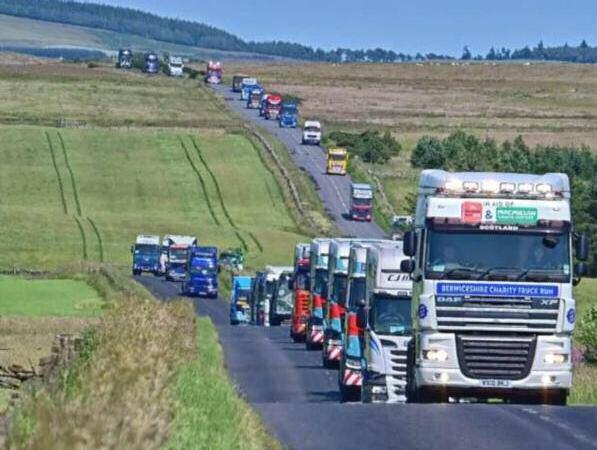
It’s been a while since I last wrote and what an unbelievable period it has been. Groundworks on the next two sheds started well in, as usual I had underestimated the sheer scale of the job in front of us, not helped by Covid and people quite frankly not wanting to work.
Throughout our lads mucked in and drove whatever Rutherford’s Groundworks needed to be driven, diggers, dumpers, crushing and screening in between turning round Border Eggs chickens…. Connop and Son had poured the ring beam and Ellerington Engineering had the steel standing!
Although I said last time, I was aiming to reduce spend other than on the new sheds, sometimes necessity and opportunity arise…
We made several investments in our fleet with a newer workshop van for Paul, a third Weidemann loader (from 2002 so DPF is not a problem), a second Merlo forklift (no ad blue on a 2009 model ), an elderly slurry tanker and a new 150cfm road tow compressor (which has been an absolute game changer for turnarounds).
Finally on a visit to Smyths Toy Shop, a bouncy castle for less than £300 made Fraser’s summer! (and mine )
June brought a MacLean Eggs turnround, which went very well, the start of the Big Dutchman deliveries and the return of Batson Electrical, chicken multi-tier soon be going up we thought!
Sadly it would be the 3rd of August until we could get concrete down on the floor, don’t even ask the price! This put us behind for the rest of the build.
July saw a welcome distraction from scouring the horizon for mixer wagons as MacLean Eggs became main sponsor of the inaugural Berwickshire Charity Truck Run
What started out as a few trucks and the hope to raise a couple of thousand pounds grew and grew and on a glorious day on the 27th July, 50 trucks toured Berwickshire and raised over £20 000!
My sincere thanks to all the businesses that we work with who sponsored, supported and donated to the Margaret Kerr Unit and Macmillan Cancer Support both based at the Borders General Hospital near Melrose
As we moved into August, Newquip’s fitters rolled into town, just sadly not enough of them Blame Brexit, Visas, Covid etc etc. These teams are predominantly Polish and move from
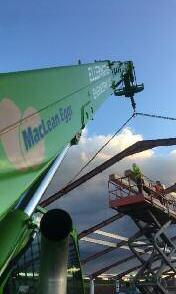

site to site living in purpose built artic lorry trailers, they have a kitchen, bedrooms and bathrooms. However when the first team of 4 people arrived, they almost cried when they saw the scale of the task ahead of them It would be October before many hands arrived to help. Brexit appears to have had a major affect on getting these lads work visas!
After weeks of delays, concrete just kept coming and the 4 floors were laid over 4 long days, we even had 2 artic concrete mixers, never seen one before, never mind the double!
Within days, poultry equipment was unboxed, bolted together and standing, just as barley and wheat were being flattened on the rest of the farm
September saw the addition of a second Labrador – Abbey – Collinson
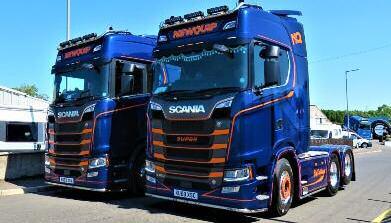


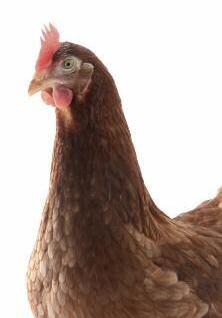
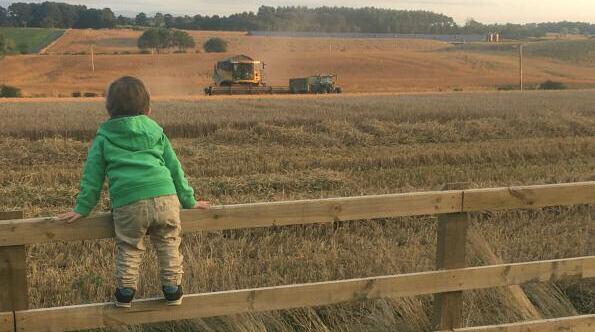
feed bins and the Prison Van.
Earlier in the year, with the prices of Transit Connects soaring, we had bought a London Taxi, which has been great for socially distant tours for visitors When the opportunity to acquire an ex prisoner transport van arose, it was a done deal. Out the cells came and we are in the process of deciding whether to make it into the creepiest motorhome I have ever seen for ourselves – Angela is not, I repeat, not a fan – or perhaps another workshop van??
Solar Panels were also added to each of the new build sheds during September by Noble Green Energy, 90kw each to be precise These along with the Power Factor Correction and Voltage Optimisation from Energy Ace go a long way to reducing our carbon footprint
and energy requirement on farm. We now have just shy of 500kw of solar and PFC’s / VO’s at each meter point and the savings are quite remarkable
The 18th – 22nd of October were the days we were aiming to put chickens in the new sheds and I knew the week beforehand it would be stressful however I had no idea that a few mice would descend into the celling of our house and in 2 days flat chew most of the 90 degree plastic water pipe bends
No one involved had seen anything like it. Cut hole in ceiling, find leak, repair, turn on water, ah over there now cut again, repeat
Nothing for it, pull the whole ceiling down and get rid of the 6 mice and put copper back instead! Any cost savings of using plastic long, long gone.
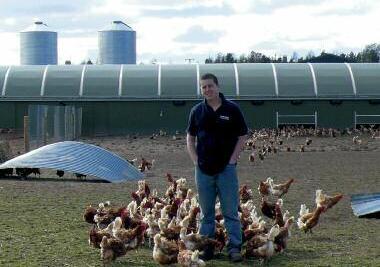
Attention quickly reverted to the sheds and I must say that the sight of 40 men working to get chickens into the sheds was fantastic, the hours were massive, the drinks bill for the shed party after we put the last bird in was equally sizable but everyone deserved it. It has been the biggest project we have ever undertaken and I must thank all concerned again for their efforts Sumo suits completed the night as a few scores were needing to be settled
My favourite part of the week was watching as 2 artics of chickens were unloaded and put on the new system by everyone involved in the build in less than one hour The lads had never unloaded birds before but every man helped to get us over the line!
Mains power finally went in late October, nearly 2 years after we first started talking to Scottish Power
Generators from George Forsyth and Alan Harper kept the lights on until then and Fox Fencing has been rattling up netting and field shelters.
November was a quieter month, not least because like many others, we were struggling to recruit new team members, I think a dozen (oh the irony) have not turned up to the job interview after confirming their attendance??
Eggs are now streaming through the newly installed Prinzen Egg packers and palletisers oh and we are busy taking down a couple of sheds on a site we have for 4 new build houses a few miles from home
Anyway must go, planning permission for more sheds seems like a sensible thing to do??
More than 10.5 million bird places in the UK, 80 million in Europe and 102.7 million hens worldwide in NATURA – the flexible modular system.
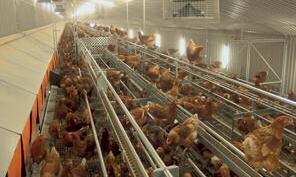

Newquip Limited, NQ House, Conygarth Way
Leeming Bar Business Park, Leeming Bar Northallerton, North Yorkshire DL7 9EE
Tel. 01677 428600, enquiries@newquip.co.uk
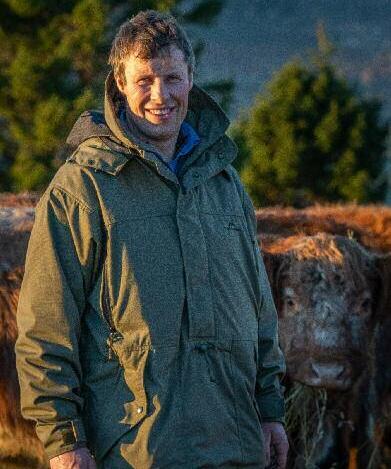
So, we ’ re charging into a new year, but partially living in the fear that not “if” but when the weather changes, we could be back to persistent rain and then snow
It was a big first for us calving 160 cows outside at -7°c in 2021 and the snow falling around these newly born calves. The cows were higher up in some reasonably sheltered country and at times it took 3 days to find their calves The cows would wander off and quickly calf in the heather, within 30 minutes the calves were cleaned up, sucked and lying in a bed of warm heather, the wind and snow blowing right over them Ten days into calving we stopped looking for them, if the cow was sucked everything was working And that became the point, we didn’t need to know when and where she had calved, but trust in her instinct We provide the nutrition and a shelter block of land and then allow them to do their job – the sheep flock operates under a similar system – you must DIY. It’s maybe an age thing and I’m not that old, but why have a dog and
bark your self? If the genetics are not fit for the environment, then it is considerably easier to select more robust genetics than battle with Mother Nature
This is really about band width and mental capacity, never have the views on land use ever moved so far or so fast. The talk of fallow land, shelterbelts, maximising input to maximise output have all been derailed in a 20-month period when cover crops are now in vogue, mass tree plantings are apparently a carbon capture tool and the fertiliser price has gone that high that it’s near unaffordable There have been many individual drivers for each reaction, but the broad theme is the same ‘The business of Climate ’ Maybe COP26 on our doorstep has really driven it home but the planet and every living thing on it is in a bit of a sticky wicket If humanity doesn’t get a handle on how we conduct ourselves quickly then there won’t be many more springs to worry about!
The climate surrounds us and it’s
Farmer: Alex Brewster & wife Jane
Farm: Rotmell - 2450 acres
Lude Estates - 6170 acres
Meikle Findowie -990acres
Location: Dunkeld
Area: Rotmell rented from Atholl Estates
Lude Estates contract farm
Meikle Findowie hourly rate
Sheep: Rotmell
750 Blackface ewes converting using Aberfield tups then Cheviots
Lude Estates
850 Cheviot ewes
350 Cheviot cross ewes
Cattle: Rotmell
190 commercial AA cows
Operates joint fattening venture with Robert Fleming, Glenluce
Lude Estates
100 Highland x White Shorthorn cattle
Poultry: Rotmell
4000 organic free range
The Egg Shed, Rotmell market own eggs
Deer: Meikle Findowie
100 hd
Jane: Architect
Staff: 8 full time
Other: Run Powered Pasture - an electric fencing company www poweredpasture co uk
Sell beef through MacDonald Butchers, Pitlochry
broadly broken down into 3 areas; the water cycle, carbon cycle, and the nutrient cycle As land users, we rely heavily upon them The issue is they are out of kilter, and everybody has become transfixed on Carbon, it’s in the atmosphere and we really need to get it back stored into the soils of the world
The broad theory is quite simple if every arable hectare in the world increased its











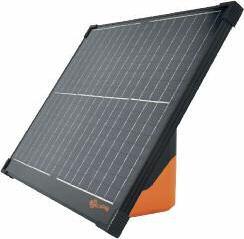
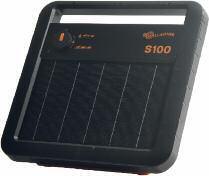



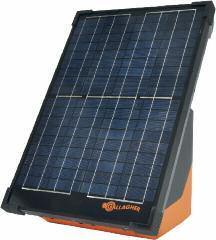






Organic matter content by 1 6% we could sequester and stabilise it all right back to pre-industrial levels in 10 years Or if the global grasslands were correctly managed then in 7 years we would have the same effect, global warming gone, finished and a conversation piece by 2030 But it’s a booming marketplace, with investment monies pouring in Multinational business buying carbon offsets but not reducing their own carbon footprint – mental and defeating the purpose The greater challenge is that the policymakers still haven’t realised that all carbon is not equal, there is sequestered carbon, effectively living biomass above the soil and not stabilised. What we really need to be focusing on is stabilized carbon, i e getting this gas out of the atmosphere and locked away in the soils for 200 plus years. Planting hectare after hectare of commercial forestry isn’t going to help achieve stabilised carbon If 40 years of
monoculture cropping has taught us anything it is that a monoculture of anything will fail, whenever an ecosystem’s diversity is reduced back to a single entity, there is no stabilisation, only leaching. And this is maybe becoming the point, that humanity and policymakers are slow learners, are we able to think holistically about the bigger picture instead of viewing everything in silos, driven by a limited mental capacity to see beyond a specific objective?
So, land use policy has been to the left, maximise production at all cost and it has a cost, environmentally Now it’s shot to the right, plant a tree and save the climate at all cost. What about feeding the people, or the pollinators, the arthropods, or the insects, how about feeding the herbivores that made the global grasslands, where the majority of atmospheric carbon should be stored. What about optimisation, how about finding a middle ground, a
space where everything has a chance to work?
Ecosystems are vastly complex and have been evolving for millions of years, they are vertically stacked and symbiotically linked, we haven’t the mental capacity to fully understand them On every hectare let’s plant a tree and grow pasture, let the pollinators, pollinate! Graze a cow and a sheep, or maybe a deer. Allow the insects and arthropods to recycle plant biomass and dung pats Let’s re-enact these past great migratory herds at a local level and mob graze The irony is that the carbon and water cycles will take care of themselves if we allow the nutrient cycle to fully function.
We’ve to aim for the middle road, aim for utopia and get the nutrient cycle up and running globally and feed everything because beavers don’t look that tasty and I’m buggered if I’m living on lettuce!
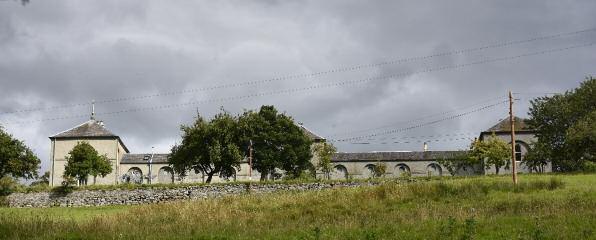
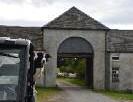
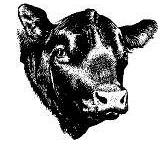

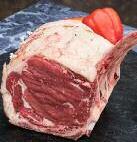
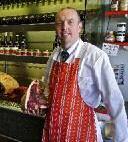
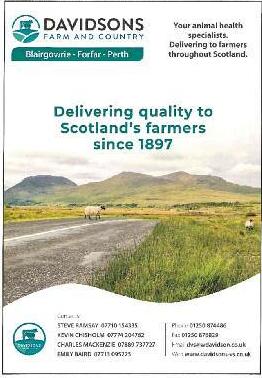
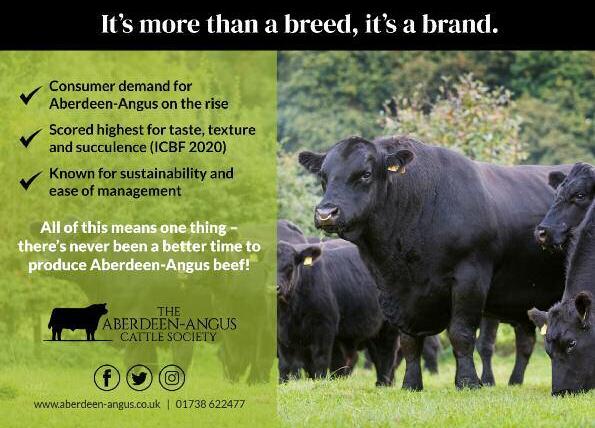
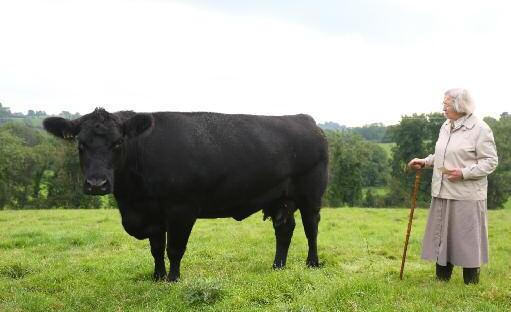
Anne Morrison founding member of the Aberdeen-Angus Quality Beef (AAQB) co-operative has been awarded an MBE for her promotion of the breed and services to the agricultural sector over the last 40 years.
Growing up on her family farm in Perthshire, Mrs Morrison has always had a passion for agriculture, so when she saw what the Aberdeen-Angus breed could offer farmers and the supply chain, she was keen to promote this
“My drive to bring Aberdeen-Angus back to the forefront of beef production stems from when I started working for the Northern Ireland Department of Agriculture in 1969 with my colleague at the time Jim Jack, who was very enthusiastic supporter of the breed,” explains Mrs Morrison “A few years later my husband and I started the Tullyglush herd with the purchase of two heifers, from which our herd has grown over the years ”
Mrs Morrison says the challenge back then was that the market demand for Aberdeen-Angus was very limited. So, along with Jim Jack and NI club members we set out to increase the
awareness of the benefits of Aberdeen Angus in the hope we could raise the appetite for this breed in Northern Ireland
“When a butcher approached the NI club for cattle in 1994, we saw this as a fantastic opportunity. A feasibility study identified a possible supply of five cattle per week In 1997 I led a successful breed promotion campaign, which resulted in the formation of the AAQB co-operative in April 1998.
“With continued promotion of the breed, we entered into a partnership with Foyle Food Group (FFG) in June, the same year, starting to send 5 cattle per week sired by pedigree registered Aberdeen-Angus bulls to the processing plant,” she says
“By November 2000 numbers had grown to 30 per week allowing FFG to supply Tesco Northern Ireland, the first retailer to have verified AA beef on their shelves and this was supplied by AAQB members This was the beginning of a very successful supply chain partnership Since then, the market has grown exponentially and our 450 members have increased their production to meet the demand,” she
highlights. “Most of the top price bulls sold at the Dungannon sales are bought by farmers in the co-operative, as they can really see the benefit of investing in good genetics” she says.
“Farmers are seeing an average bonus of over £100 per head by supplying verified Aberdeen-Angus cattle ”
Mrs Morrison says the breed is in a much better place now than it was 40 years ago.
Robert Gilchrist, acting CEO of the Aberdeen-Angus Cattle Society says, the tables have really turned for the breed in Northern Ireland due to the work Mrs Morrison has done with AAQB
“There are many farmers producing high quality Aberdeen-Angus cattle in Ireland to satisfy what is now a strong demand from processors and retailers What has also made a difference is that thanks to AAQB showing the true value of the breed, farmers in NI have received significantly greater returns for their prime cattle,” he explains
“Mrs Morrison is very worthy of this MBE and it’s fantastic that her work for the breed and sector has been recognised,” he concludes.
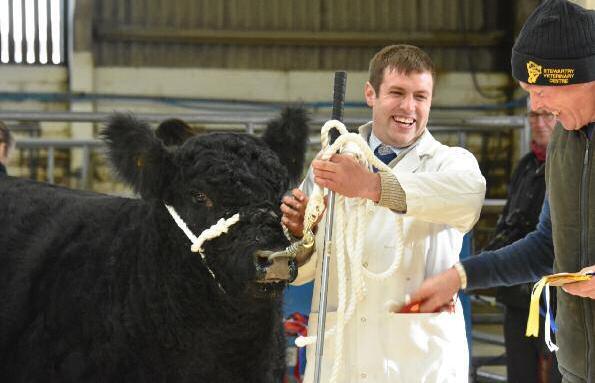
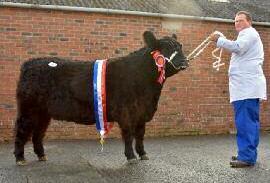
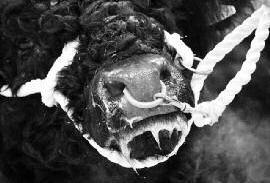

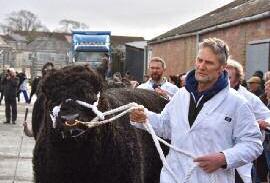
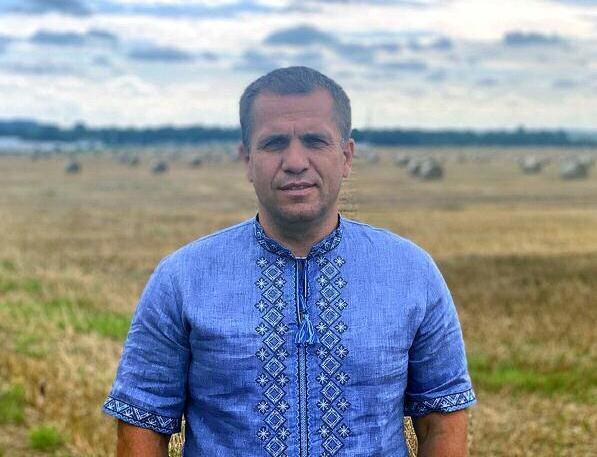
EVEN with all the hostilities going on around him, Ukrainian farmer
Serhiy Ivaschuk has despatched his tractors and machinery to work in the fields to get this year ’ s crops planted
Serhiy operates a mixed dairy and arable farm with just under 7000 hectares in the west of Ukraine at Khmelnytskyi region, 350kms south west of Kyiv and 240kms east of Lviv
While the Russian invasion of Ukraine is destined to affect food security around the world, Ukrainian farmers are making a gallant effort to get as many crops planted as they can, where they can.
The Ukraine Ministry of Agriculture has said the projected hectares for the main spring crops in territory controlled by Ukraine is 5 9 million hectares, which is 1 7 million hectares less than last year
With this in mind Serhiy and his team are forging ahead with their own crops,
which also includes growing feed for his 1400 dairy cows
Serhiy, whose farm is called Perlyna Podillya Ltd, said: “Our farm runs both livestock and arable enterprises We operate 6800 hectares of arable land and keep 1,400 dairy cows
“Mostly we grow wheat, corn, sunflowers, barley, soya, rapeseed, sugar beet, potatoes and fodder crops
Around 25 percent of our growing area is used to grow wheat and then corn, sunflowers and rapeseed are the next most popular Last year we were able to harvest 7 4 tonnes of wheat per hectare ”
Armed with whatever agricultural inputs he has available on the farm, Serhiy has already started land preparation and planting.
He said: “This year we are trying to keep the same sowing structure as last year However, it’s hard to predict that for now We’ve started sowing with the available agri inputs of seeds and
fertiliser we have on the farm. If we don’t get more inputs, then the sowing structure will be changed
“This year we have to make every effort to grow as much a harvest as possible As most farmers are unable to plant this year, the regions with no active hostilities are hugely responsible for our country’s food security,” he said
Although there are no hostilities in the immediate region where Serhiy’s farm is based, the airstrikes and missile attacks on neighbouring Lviv and Zhytomyr regions have become more frequent
Serhiy said: “We are already working in the fields feeding spring-time crops and preparing the soil for planting others. The fieldwork has slowed down a little bit because some of our workers have been mobilised to join the army or territorial defence forces Some of our farm vehicles have also been given to the Ukrainian army to use ”
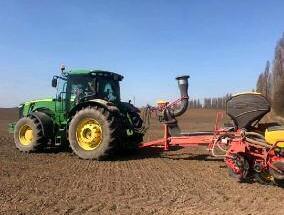
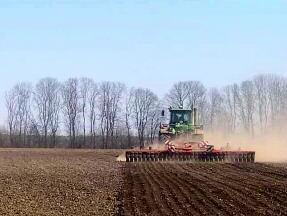
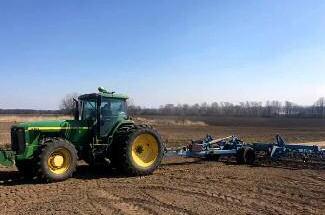
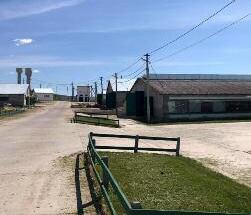
by Chris McCullough
Diesel availability is one of the more concerning issues Ukrainian farmers are facing during this planting season and further into harvesting
Ukraine normally imports around 60% of its diesel requirements from Russia and Belarus and a further 25% by sea through the ports However, as these supply lines are defunct, and Ukraine only produces 15% of its own diesel, then it has to buy from European countries next to it
The normal requirement to June is 250 000 tonnes of diesel but there are only an estimated 50 000 tonnes in Ukraine This figure may even be less now as some stocks have recently been blown up by the Russians.
Regarding his own situation, Serhiy said: “Our own agri inputs are more or less sufficient for now and the diesel stocks should be enough for the sowing
“We may run short of seeds, fertilisers and crop protection products
Before the war started we had made several pre-payments for supplies from our credit lines
“However, the logistics and supply chains are broken now, so our suppliers can’t provide us with the inputs Anyway, we will be sowing with what we have now, ” he added
Ukraine has around 35 million tonnes of grains and oilseeds in storage from last year and needs seven million tonnes of that for domestic consumption The remainder that is destined for world markets cannot be sold due to the Russians cutting off export ports
Serhiy said: “We have a lot of corn and some wheat in storage to sell. As our farm is located far away from the seaports, we usually export through the Polish border by railway
“Today there are logistic restrictions and we can’t use the railway for this But exports now would help us to get working capital for future guarantees
“We use wheat stocks for the internal needs and supply to the regions where hostilities take place and there is also a need to support the army and people Our farm work now concentrates on ensuring food security of the country ”
Ukraine president Volodymyr Zelenskyy told the recent G7 summit that a global food crisis could come as a result of the war
President Zelenskyy said: “There has been a global catastrophe Russia has destroyed the global security architecture and dealt a powerful blow to international relations But this is just the beginning This war could be followed by a global food crisis.
“The longer there is no peace in Ukraine, the less food the world market will receive from Ukraine In many countries in Asia, Africa and Europe, there may even be extraordinary problems with access to basic products and food prices,” he said
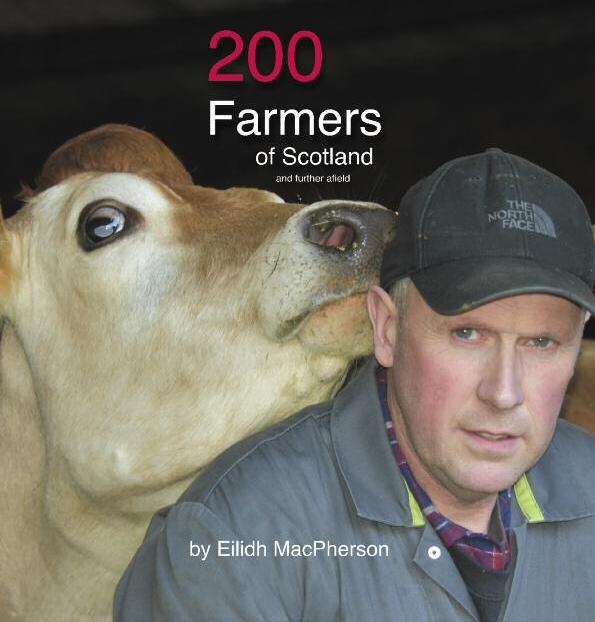
BOOK – 200 Farmers of Scotland – NOW £20 when ordering direct
Every farmer has a story to tell This book covers the diverse range of Scottish farmers and crofters from those farming the rugged hills of the Highlands to the sandy loams of the Lowlands. From owner occupiers, tenant farmers, share farmers, crofters, farm managers, starter farmers, to new entrants, farming from 10 acres to 31 000 acres – the people are as diverse as the landscapes and environment in which they work
Scotland covers 7.8 million hectares, of that 5.7 million or 73% is farmland, or 79% if common grazing is included.
This book has photographs of 200 farmers and interviews with 109 from across the country from Orkney to Berwick and Durness to Stranraer within its 288 pages. It is available from individual bookshops and farm outlets or direct from the author. To order direct: drop an e-mail to Eilidh MacPherson at editor@farmingscotland.com or private message on facebook – farmingscotland.com for details.
Send cheque for £25 to:SUBS, farmingscotland com, Marbrack Farm, Carsphairn, Castle Douglas, DG7 3TE
NAME:
ADDRESS:
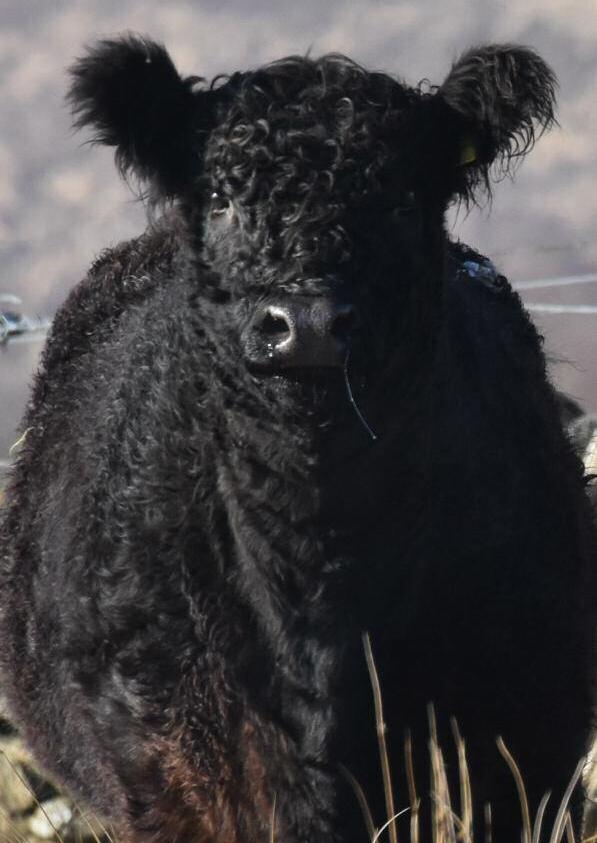
START ISSUE:
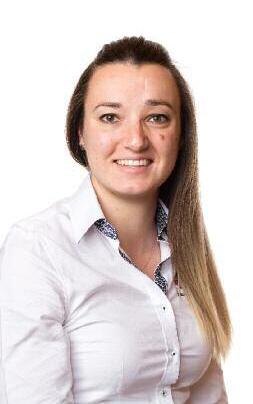

Farmers are being urged to take control of silage quality this year by pre-cut grass testing to ensure grass is harvested at the optimum time
According to Lientjie Colahan, sales and technical support at Lallemand Animal Nutrition, pre-cut testing is a critical part of the silage making process to maximise forage quality and fibre digestibility
“Forage is the cheapest feed available for dairy and beef systems, improving its quality will increase production from forage, reducing reliance on purchased feeds. This will significantly benefit production margins, especially during years when feed prices are disproportionally high,” she advises.
To help farmers determine the best time to cut grass for optimum quality silage, Lallemand Animal Nutrition is offering free pre-cut grass testing this season
“Farmers often fall into a routine of following the same cutting patterns as previous years, rather than being
governed by the grass quality of the current season This can prove costly due to the variation in the weather and growing conditions, therefor testing should start around three weeks prior to the date of your first cut last year, ” explains Mrs Colahan
The Opticut system enables producers to take a planned approach when it comes to maximising the quality and quantity of grass silage throughout the growing season, to fit the requirements of their farm
There are three key elements to the system. These include: pre-cut grass testing, correct management of the silage making process, and use of a crop and condition specific inoculant to improve nutrient retention and reduce losses from aerobic instability
Monitoring nitrogen application is also important as this affects grass growth
“One of the most important elements to determine in pre-cut testing is the neutral detergent fibre (NDF) content This is the main gauge of plant maturity,
giving the best indication of when the grass is ready to cut If nitrogen application is significantly altered, the grass may become stressed and go to head earlier” explains Mrs Colahan
“Pre-cut testing should be carried out until at least the third cut, ideally continuing throughout the season ”
She suggests also keeping contractors informed about proposed forage plans for the year, providing a rough estimate of when you think your first cut will be, and updating them according to pre-cut results
“By regularly testing your crop throughout the season and acting on these results, farmers will be able to set up the foundations to produce good quality silage with improved nutritional value,” says Mrs Colahan.
Lallemand Animal Nutrition has been working alongside farmers to improve forage quality and utilisation for over 25 years To get your free pre-cut grass testing kit, please call: 01684 580022

Upcoming changes to dairy genetic evaluations will lead to a slight shift in the running order in the AHDB bull rankings published next month (5 April).
All three major selection indexesProfitable Lifetime Index (£PLI), Spring Calving Index (£SCI) and Autumn Calving Index (£ACI) – will undergo updates to reflect increases in input costs and the price of milk
Each index's formula has been adjusted to reflect changing economic conditions and the ongoing needs of dairy processors and farmers Most notable financial changes are in feed, labour and replacement costs, as well as in the value of cull cows since the last update in 2018
The changes result from consultation across the industry, which is undertaken routinely by AHDB, working with market specialists and through the Genetics Advisory Forum (GAF). Stakeholders in the forum include farmers, breeding companies, vets, milk processors, the RSPCA, milk recording organisations and breed societies These participants collectively review the genetic progress dairy breeds are making, the long-term market outlook for inputs and output, and they fine-tune the three economic indexes as the need arises
The indexes were last updated in 2018 and before that, in 2014 Each continues to be formulated to suit a manufacturing contract, reflecting both an industry shift in this direction and some value in producing components, even in liquid markets.
To address the rising significance of feed cost, Feed Advantage (FAdv) will also be added to £PLI. A combination of Maintenance Index and a genomic prediction of feed efficiency, FAdv was developed from extensive trials over many decades measuring actual feed intake in relation to a cow's size and milk production
Currently only available for the Holstein breed, which took part in these trials, all other dairy breeds will continue to use the Maintenance Index, which acts as a proxy and is based on a prediction of feed efficiency based on the size of the cow Maintenance will also continue to be used in the across-breed indexes, £ACI and £SCI, for all breeds
Another change to all three indexes and all breeds is the inclusion of the genetic evaluation for Digital Dermatitis (DD). This follows ongoing work at the University of Liverpool, which showed the AHDB genomic evaluation for DD was very effective in predicting the odds of a cow having DD As a result, DD will now be included alongside Lameness Advantage (LAdv), which was introduced in 2018 By using both LAdv and DD Indexes in harmony, more rapid genetic benefits can be achieved to help tackle lameness, as they offer distinct and different benefits
For the £SCI only, additional changes will be made with the April proof run This will see bulls whose daughters are heavier penalised more severely for spring block calving, grazing based systems. This move has been driven by feedback from farmers running grazing
systems, many of whom place a higher value – over and above purely the additional maintenance feed cost – on the lack of soil damage and ease of management smaller cows can bring.
Marco Winters, AHDB head of animal genetics, says cattle breeding is a long-term business and the economic model ,which sits behind the changes considers the outlook five to 10 years ahead
"At the time of the 2022 update, we see more volatility in the market for inputs than on previous occasions," he says "However, we don't know how sustained current prices will be, so we have to base our decisions on longer term projections, but will continue to carry out regular reviews and may have to make adjustment if circumstances dictate "
He also remarks that the relative emphasis between production, health and efficiency has not significantly changed in any of the indexes, such that each continues in its previous direction of travel for each type of farming system This places around two-thirds of the value of each index on health and efficiency and one third on production
The £PLI is tailored for year-round calving herds and is a within-breed index; the £ACI is an across-breed index, designed for autumn block calving herds producing much of their milk during the winter months; and the £SCI has been formulated specifically for herds with a heavy reliance on grazed grass which calve in a tight block in spring, and can also compare animals across breeds
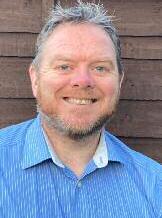
James Bannister was elected as new NAAC Chairman at the AGM on 4th March 2022 Taking over from previous Chair Matt Redman, James runs an agricultural contracting business in the Yorkshire, Lincolnshire and Nottinghamshire borders spreading manures and lime, alongside crop spraying
However, it was in 1998 that James’s life was drastically changed when he lost his left arm in a farm accident, having become entangled in a potato harvester It has taken over twenty years to successfully rebuild his life and business, JLR Farm Services and James is now in a position to want to help others stay safe on farms
“If just one person changes the way
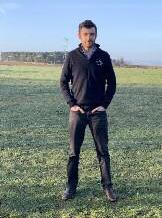
In partnership with SAOS, NFU Scotland has launched the Scottish Agricultural Export Hub to develop new export opportunities and expand existing export markets for Scottish agricultural produce for the benefit of primary producers
The Hub will be delivered by NFUS and SAOS with funding from the Scotland Food & Drink Partnership’s Recovery Plan, which is supported by the Scottish Government.
Scotland’s farming, fishing, food and drink sector is a £15 billion industry, employing 120 000 people in communities across Scotland But all too often, the existing supply chain does not deliver for primary producers
This new initiative will focus on the
they operate, based on my experience, that will be one life potentially saved,” commented James “In my new role as NAAC Chairman, I want to drive the Association forward, whilst putting particular focus on trying to improve our dreadful industry safety record.”
“As finances tighten and skilled, trained labour is harder to source, ” said James, “it becomes more tempting to cut corners and push boundaries However, it is critical to focus on safety management to ensure that all our contracting workforce is kept safe and is supported I am passionate about farm safety and am honoured to be Chairman and have the unique opportunity to try and make a real difference to our industry ”
Origin Fertilisers has added to its young team of in-house nutrition agronomists with the appointment of Hamish Stenhouse to cover Scotland and the Borders
Mr Stenhouse’s appointment is part of a trio of recent additions to Origin’s regional nutrition agronomist advisors, with all three recruits hailing from practical farming backgrounds.
A graduate of Harper Adams, Mr Stenhouse has spent the past six years working for a well-known farming operation in Tayside and during that time rose to the role of assistant manager and says his experiences here stand him in good stead for his new post
“I’ve spent a lot of time operating a fertiliser spreader and developed a keen
potatoes, cereals, fruit and vegetables sectors to expand the market horizons and connections more directly for primary producers and to seek out markets where a higher return may be possible, to drive more value down the supply chain Success in export markets will support a sustainable, profitable farming sector in Scotland
Patrick Hughes, the former Head of Potato Export Development at AHDB and former Head of Seafood Scotland has joined SAOS to drive the initiative forward.
Patrick brings more than 25 years of experience across the agri-food sector to deliver this project and will be supported by an NFUS farming steering group
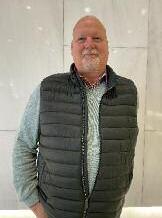
interest in how the products I was applying affected the plant I worked across a wide range of soil types, which meant we regularly had to adapt our soil and crop nutrition programmes to cater for the different areas
“I have a particular interest in how using fertiliser in a sustainable way can translate into a healthier crop I also want to demonstrate that by purchasing fertiliser with a known carbon footprint, can in turn help farmers reduce their own carbon output,” he says.
One of Mr Stenhouse’s other focus areas will be product development and making the most of new technology He will be covering the whole of Scotland and the Borders in his new role and is currently studying for his FACTS qualification
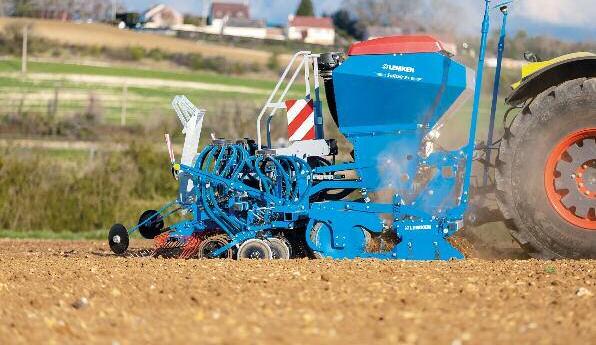
The National Association of Agricultural Contractors (NAAC) is warning farmers and land managers that contracting prices will have to rise in the coming days and weeks
Commenting James Bannister, NAAC Chairman stated, ‘As fuel prices double and continue to climb, machinery costs spiral and labour remains at a premium for skilled operators, it will no longer be possible for agricultural contractors to retain static prices Looking at the escalation in input costs, with spring work potentially only days away, professional contractors will have no choice but to increase costs to sustain their own businesses’
Contractors are always trying to find the right balance to retain a loyal customer base, whilst keeping pace with rising inflation, but offering the cheapest service is now a clear road to heading out of the industry. Machinery replacement costs and keeping good labour were already causing a massive headache for contractors, before the current fuel hikes In the last few days
red diesel prices have leapt from 80ppl to well over a pound and climbing, with fuel getting harder to source.
“Only the foolish will try and cling to stationary prices this spring, as any contractor that understands their own costs will recognise that price increases are vital to keep pace, earn a living and retain some stability and longevity in their business,” said Jill Hewitt, NAAC Chief Executive
“Many farmers now rely on their contractor to take on roles that they may no longer have the labour, skills or machinery to complete – but contractors cannot be expected to bankroll their customers and the industry must brace itself for price rises ”
The expectations on contractors continue to escalate Environmental protection, specialist training, record keeping and having the latest technology on board, all require a new level of expertise and equipment. However, it is currently the costs of the basics that are forcing tough decisions
“Contractors, like the rest of agriculture, are being forced to look

hard at their bottom line and escalating business expenses will need to be passed on, ” said Meurig Raymond, NAAC President.
“A successful contractor will need to cost individual operations carefully and accurately and for a farmer to bring in a reliable, professional contractor that has trained staff, working safely, with well-maintained kit, this will come at a cost ”
The NAAC has recently launched a new on-line pricing tool for its membership, with Andersons Consulting, to allow contractors to evaluate each operation, taking into account all costs, so that they can see the cold, hard facts for each job This will allow quotes to be made, backed up by statistics, to get to a price that is realistic for the current economic climate.
It will become increasingly apparent that ‘ you get what you pay for ’ and the farmers and contractors must work in partnership to ensure all businesses can remain viable, productive and sustainable, today and in the future

POTTINGER introduced its new Jumbo 7000 silage wagons following a complete redesign and feature upgrade
Designed for tractors from 200hp up to 500hp the new third generation Jumbo range comes with a new driveline and a facelift
Other features include the seven-row controlled floating pick-up with a working width of 2 3m The pick-up’s new hydraulically adjustable drive system adapts the speed automatically to the driving speed
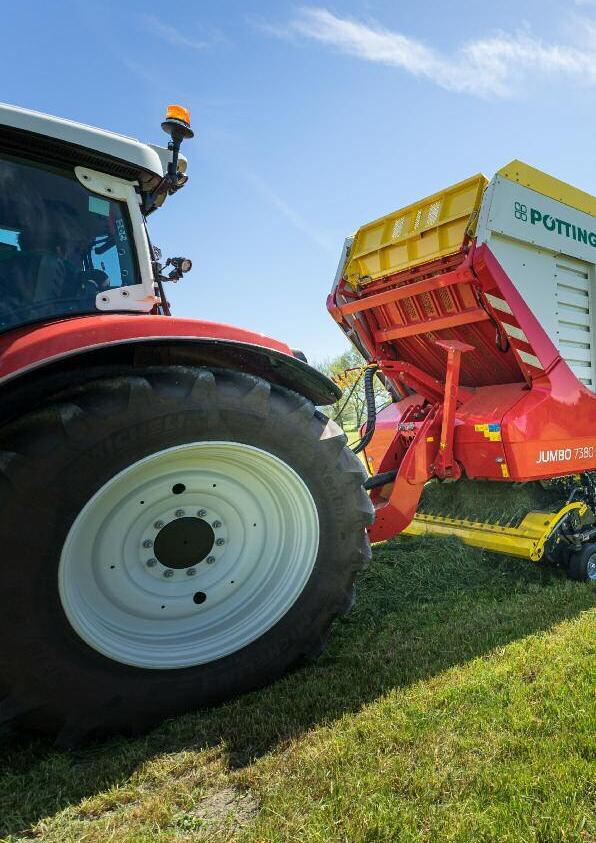
There is less of a dragging effect and the result is perfect chopping quality
The jockey wheel steering system can be engaged to enable even better ground tracking
The pick-up position control, which is supplied as standard, keeps the
cross-section of the opening between pick-up and drawbar constant to ensure maximum throughput during the entire loading process
The tines, which are controlled in a sweeping arc by the cam track, convey the crop gently upwards and actively transfer it to the rotor at a suitable speed Instead of dragging the forage through, they promote the best possible chopping quality The tines then dip down at a right angle to prevent the forage from being drawn in
The Powercut short-length chopping system has an asymmetric array of 48 knives and a theoretical chopped length of 34mm The knife bank release system, handled without the need for tools and the central knife release system are operated conveniently using a control panel to the side
The driveline has a double wide-angle PTO shaft without a clutch and is powered by a Powerband Optimum power transmission to the rotor is ensured by angular/planetary gears in the rotor drive
Loading rotor
Around 75 percent of the rotor's width is fitted with a new high-strength case-hardened steel that ensures high wear resistance in areas subjected to a lot of wear This increases service life by 25 percent
With the new unloading beater
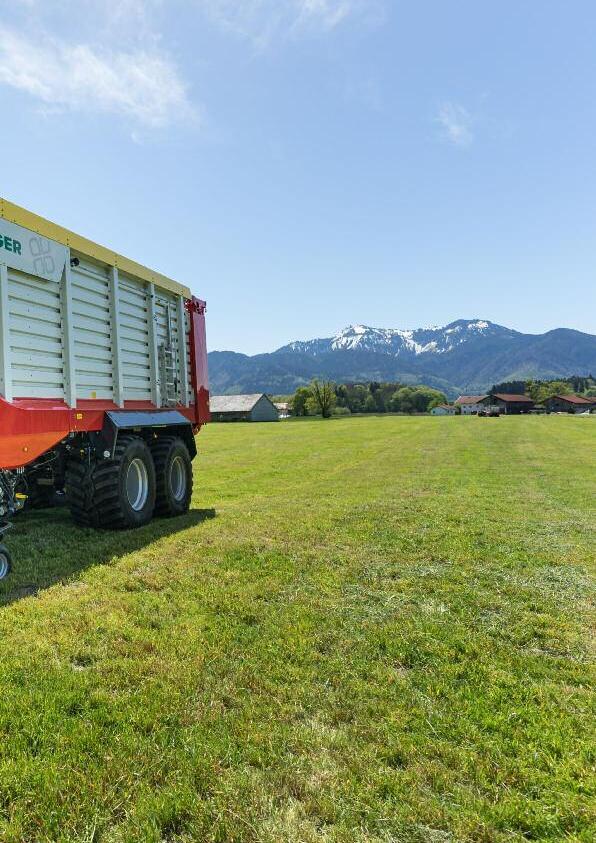
driveline that delivers 210kW, unloading capacity has been increased by another third taking around one minute to empty
The moveable front panel provides a significant increase in volume of 4 3m3 for the same length of wagon This also makes the loader wagon much more compact
The patented, intelligent front panel enables a unique loading and unloading strategy Available as an option, its length of 830mm means it has a particularly generously dimensioned upper forage compression flap.
An additional dynamometer bolt is fitted in the intelligent front panel to enable a new control concept The loading pressure is now measured at the front panel With the combination of all measuring points (loading torque sensor, dynamometer bolt, compression flap sensor), the degree of compaction and the desired filling level can be directly regulated
As a result, the parameters can be perfectly adjusted to the forage harvesting requirements With the active forage compression flap, unique loading rates of up to 400 kg/m3 can be achieved if required, depending on the DM content
Three predefined modes can be selected for loading, ranging from light loading to medium compression to high compaction. They enable optimum adaptation to different types of crop, the dry matter content and the degree of filling
If the scraper floor is actuated by the automatic loading system, the front panel helps push the forage along and then automatically moves back into the loading position This ensures that the forage stays extremely compact
In addition, two 2-speed motors, mounted externally on both sides, and a patented boost function, ensure maximum unloading performance To give the driver a clear view from the tractor into the loading chamber or for driving in under the harvester auger in harvest transport mode, the
compression flap can be hydraulically folded forwards
The scraper floor has been lowered at the front by 250 mm to reduce the power required during loading This also increases the net payload thanks to higher compaction The wide flat link chains with a breaking load of 13t provide great stability, maximum reliability and smooth running
by Chris McCullough
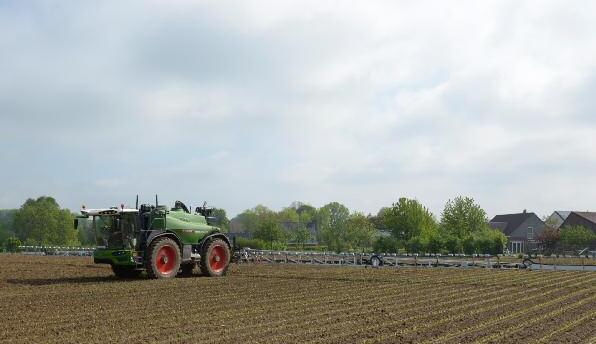
by Chris McCullough
WITH global agriculture focused on reducing the use of herbicides US machinery company AGCO has joined forces with other specialists to create new targeted sprayer technology
Using targeted sprayer technology can ultimately reduce the use of herbicides as it only applies the chemicals where necessary, rather than the traditional blanket treatments
AGCO has entered into a proof of concept (PoC) collaboration agreement with Robert Bosch GmbH, BASF Digital Farming GmbH and Raven Industries Inc. (NASDAQ:RAVN). Their collective goal is to make the application of crop protection products more effective and efficient by reducing crop input costs while driving farm and environmental sustainability
To support the reduction in herbicide application, the targeted spraying PoC will focus on real-time sensing technology to make crop protection decisions By detecting weeds in growing crops as well as on fallow ground, day or night, this technology will execute precise targeted product placement down to the individual plant level
In addition to the environmental benefits, targeted spraying will help enhance farmer profitability by only spraying the herbicide where needed.
This makes the use of more efficient herbicides affordable allowing for much better weed control Where optimal herbicides are already used, the smart sprayer provides a volume and cost reduction
The initial concept is being evaluated on a Fendt Rogator sprayer in Europe with plans to extend to North America later this year
Seth Crawford, senior vice president and general manager, Precision Ag and Digital for AGCO, said: “Farmers have long been searching for innovative ways to minimise chemical usage and reduce passes through the field to achieve their crop protection goals
“Combined with the potential for further regulatory pressure, we believe this collaborative spraying effort advances our farmer-first focus and is further evidence that we will work with the best-in-class partners to serve farmers’ needs
“This effort is aimed at validating targeted spraying solutions, delivering a reduction in product use to achieve the same results as broadcast spraying in both pre- and post-emergence with the flexibility of spraying day or night,” he said.
Coupled with AGCO’s application equipment expertise, Bosch brings capabilities in hardware, machine learning and artificial intelligence as
well as digital services
Xarvio Digital Farming Solutions provides an automated, real-time, in field agronomic decision-making engine for weed management and crop optimization
Raven Applied Technology adds it is committed to sprayer efficacy and operational efficiencies that further enable precision control of chemicals for targeted spraying applications
The combined power of the technologies that this collaboration is focused to deliver will empower farmers to drive greater efficiency in their operations while helping to protect the environment through reduced chemical usage in line with AGCO’s commitment to providing farmer-focused solutions to sustainably feed the world

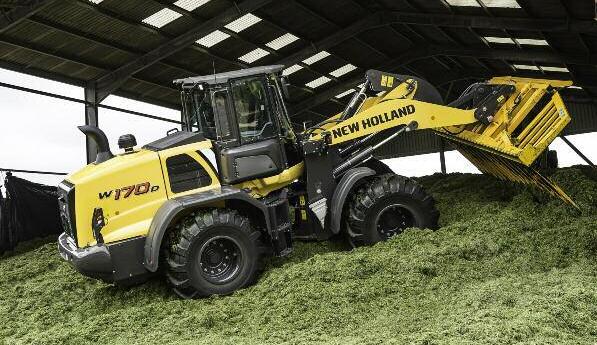
NEW Holland has revamped its D Series wheel loaders with state-of-the-art technology that the company claims can reduce the total cost of ownership by around 20 000 euros.
Powered by 4.5litre and 6.7litre NEF High Efficiency Selective Catalytic Reduction HI-eSCR engines, the range consists of W110D, W130D, W170D and W190D models
Compliant with Tier 4B emission regulations, the NEF power units have been co-developed with New Holland sister company FPT Industrial The latest ECOBlue and HI-eSCR technology employs a newly developed electronic control unit that manages both the engine and the HI-eSCR exhaust to precisely match engine load, emissions and after-treatment
Using a dedicated closed loop system to continuously monitor NOx levels in the exhaust, HI-eSCR precisely monitors the flow of AdBlue. This will achieve more than 95% NOx conversion with minimised AdBlue usage.
New Holland says it has introduced two major improvements focused on fuel usage and maintenance costs which, together, can deliver up to 20 000 euros in savings during the machine’s life cycle
The first innovation is the new Smart Work mode that delivers up to 10% fuel savings on a machine that already stands out for its fuel efficiency
The other major improvement is the extension of service intervals from 500 to
1000 hours, which delivers up to 20% savings.
Inside the cab the eight inch colour display now features a touch screen for a more user-friendly operation. The new configurable quick-access buttons mounted at the operator ’ s fingertips allow to interact with the screen without interrupting operations Plus, the self-levelling mode makes fork handling easy ensuring parallelism to the ground The payload scale is designed to accurately monitor the quantity of material loaded, and the tyre pressure monitoring system ensures tyres are always operating at the optimal pressure, reducing fuel usage and tyre wear
The excellent visibility provided by the one-piece windshield and rear-view camera is further improved by the optional enhanced lighting pack. With 43 000 Lumen, it turns night into day for safe and efficient night-time operation.
Alain de Nanteuil, New Holland light equipment Europe leader, said: “Forage harvesting contractors and biogas plant owners already love our wheel loaders because we focus on the features and functions that matter most to them
“Our machines push and climb fast for up to 17 hours a day, with superior uptime, when clamping silage They are equally ideally suited to biomass digester loading With the outstanding improvements we have introduced, we think this is the most exciting wheel loader New Holland has ever produced,” he concluded
by Chris McCullough
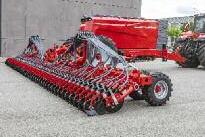
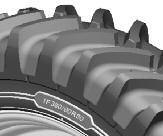
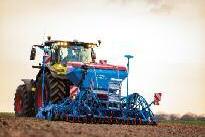
HORSCH has expanded its drill range with the addition of the new Avatar M line model with an 18m working width
The company already has numerous Avatar direct drills working across the world from Australia to central Europe to North America, with working widths of 12m, so this one offers extra capacity
This M line is based on a new central frame concept for the seed wagons to create different options for hopper partitions and hopper systems The new Avatar 18 M is equipped with a triple tank system with three separate chambers and offers a significantly larger hopper capacity than other machines that are already on the market
The division of the three hoppers into 2000 litres, 5300 litres and 5300 litres allow for metering up to three components separately and precisely These can be placed simultaneously by the well-proven SingleDisc seed coulters. Using the optional weighing system, the driver can see from the tractor how much is in each hopper This adds another safety factor in addition to the standard residual quantity calculation
The large chassis tyres minimise the pressure on the soil and reduce compaction even if the hopper is full or the soil is wet The SingleDisc seed coulters can be adapted individually to different conditions and provide precise seed placement for optimum growth.
The WorkLight Pro LED headlight system improves night operations and allows operators to see the seed coulters clearly in the dark A half-width shut-off is standard, enabling the driver to save seed and fertiliser on the headlands or in wedge-shaped fields, while optional pushed trash wheels are available to remove organic residues from the seed horizon
TYRE specialist Michelin has announced its new AgriBib Row Crop IF (Improved Flexion) tyre is now available in five sizes
Designed specifically for use on self-propelled and trailed sprayers and on low to medium horsepower row crop tractors from 70 to 180 hp, the new range was launched last year initially in IF 380/90 R50 167A8/167B and IF 320/85 R38 151A8/151B fitments.
Farmers and agricultural contractors can now also choose the tyres in IF 380/90 R46 165A8/165B, IF 320/90 R54 159A8/159B and IF 320/90 R50 158A8/158B sizes
Gordon Brookes, Michelin’s customer engineering support manager, said:
“Today’s sprayers have larger and larger tanks to increase productivity and reduce the number of trips a farmer has to make to refill
“To adapt to this new trend, we have developed the Michelin AgriBib Row Crop IF range, which allows a heavier load capacity to be carried at the same pressure compared to a standard tyre, while having more lugs on the ground and improving traction in muddy conditions.
“When these tyres are used on tractors, which do not need an increase in load, the farmer can also work at a lower pressure due to the IF standard, resulting in reduced soil compaction,” he said
All tyres in the new range benefit from Michelin Ultraflex technology which ensures a larger tyre footprint to protect the soil, improving crop yield and productivity, while their strengthened sidewalls make them extremely durable when operating at low air pressures
FOLLOWING on from the launch of the Solitair 9+ pneumatic seed drill, Lemken has also introduced its new Duo version with divided seed hopper
This machine offers a wide range of options for simultaneously spreading seeds, fertiliser and even catch crops The seed hopper of the Solitair 9+ Duo holds 1,850 litres and this capacity can be split 50/50 or 60/40, depending on needs As a result, two application variants are possible
In the single-shot version, seeds and fertiliser are combined downstream from the two metering units in each of the two hopper segments. The different components are guided to the double disc coulters via a seed pipe and deposited in a seed furrow This allows a suitable starting dose of fertiliser to be added for winter sowing or a complete fertiliser application for summer sowing An automatic tramline mechanism is integrated into the distributors
The second double-shot system provides greater deposition flexibility –the two components flow separately to a double disc coulter via doubled distributors in two seed pipes They can then be spread either in a single row, as with the single-shot method, or separately and alternately in two rows following a quick exchange of the tramline cartridge in the distributor
In addition, the deposition depth of every other row can be adjusted separately via the pressure roller up to a difference of 5cm This allows two different seeds to be placed at different, optimum seeding depths or inter-row fertilisation to be applied while seeding The Solitair 9+ Duo is available in work widths of three and four metres

The NEW ARION 400 comes as standard with
• Intelligent operator assistance systems – giving you an easier life
• Smart data management – simplifying your documentation
• Ef cient connectivity – improving your work processes
• Exceptional cab comfort – making your day more productive
Call SELLARS today for a demonstration.
Learn more about the new ARION 400.
SELLARS Oldmeldrum Tel: 01651 872891
SELLARS Cupar Tel: 01334 658210
SELLARS Forres Tel: 01309 676708
SELLARS Huntly Tel: 01466 792165
SELLARS Letham Tel: 01307 818545
SELLARS Perth Tel: 01738 620549
sellars.claas-dealer.co.uk
Find us on facebook.com
Search Sellars Agriculture Ltd
FINNISH tractor specialist Valtra made the most of its 70th anniversary in 2021 by introducing new 5th generation N and T Series tractors
Continuing on with its introduction of 5th generation tractors after launching the new G and A Series tractors, the focus now is on even more technology and smart solutions in the new N and T Series tractors
Mikko Lehikoinen, Valtra vice president, sales and marketing, said: “The new tractors are not only good looking, they are also easy to use, they have many new smart functions, and they are extremely comfortable to operate.
“We have made plenty of improvements in the new series based on customer feedback on our award-winning fourth generation tractors Precision farming is at the centre of the new generation, and each new model is available with Valtra Connect
“New legislation, such as the European Green Deal, is accelerating the

need for precision farming and agriculture will change more in the coming years than it has changed in recent decades
“We believe that precision farming technology will play a key role in
achieving sustainability goals Ensuring that the right technology is used in the right place at the right time will help improve agricultural productivity Valtra is ready to support farmers in this change,” he said
Taking a closer look at the new 5th generation N and T Series tractors they come with redesigned cabs, a new look, new transmission and engine features, and a completely new smart display
One of the most visible new features on the tractors is the display on the A-pillar, which replaces the traditional
instrument panel behind the steering wheel and where all the important information can be easily seen on the colour screen
The top of the display always shows default information, such as the driving speed, engine speed and time Below that, the operator can select information for controlling the tractor and implement, precisely in the desired format The display also shows the radio station and smartphone information over Bluetooth
The same display can also be used on Va l t r a U n ve i l e d 5t h G e n e r at i o n N a n d T S e r ie s Tr a cto rs
HiTech and Active models to make all engine, hydraulics and transmission settings The display presents all settings and stages clearly, allowing the operator to get much more out of the tractor On Versu and Direct models, the A-pillar display and SmartTouch divide the tasks according to suitability and also the preferences of the operator
When climbing into the cab of the 5th generation N or T Series, it is obvious that the tractor has been thoroughly revamped
The steering column is completely new, and adjusting the position of the steering wheel is now easier.
Valtra’s acclaimed forward-reverse shuttle lever has been updated, making it now easier to change directions when switching between different controls such as the SmartTouch lever or the
TwinTrac shuttle The steering wheel is a little bigger than before but still handy in size, as is characteristic for Valtra tractors
Starting off in the B and C speed ranges is easy, even with a heavy load, thanks to the new Start Boost feature Changing between speed ranges is now faster, which is noticeable especially at road speeds.
Operators can carry out work more efficiently when based in a comfortable cab In SmartTouch models, the right side of the cab has been redesigned, and the seat swivels even more to the right The right control panel also has a handy phone holder and optional USB charging points for mobile phones, tablets and other electronic devices
The upper part of the backrest on the new generation Valtra Evolution seat swivels with the driver and also provides support when the driver has partially turned around to look at the implement at the rear
A higher-quality dark Premium interior is available as an option in the
cab and includes, for example, a leather-covered steering wheel, partially chrome pedals and rubber padding at the bottom of the storage compartments
Around two in three new Valtra tractors are equipped with automated steering or advanced smart farming solutions already today Customers can also specify their new N or T Series tractor with Valtra Guide autoguidance and smart farming features such as Task Doc and Section Control. Task data can be transferred seamlessly between the tractor and farm management software
The brand-new Auto U-Pilot combines Valtra’s innovative headland management system with Valtra Guide Auto U-Pilot controls the implement with more precision in the headland, reducing the amount of attention required by the operator and making their job easier
The amount of software options is increasing rapidly with the growth of smart farming technology, and Valtra customers can easily update the latest features to their SmartTouch tractors

by Chris McCullough
MASSEY Ferguson has launched a new range of six telehandlers in its popular TH Series with a host of new options and redesigned cab
Taking some influence from the new MF 8S tractor series, this latest generation features a similar stylish cab and a number of new options including in the transmission The engineers really focused on the operator with additional automation for the boom suspension, parking brake, boom height setting and third hydraulic function controls
All models are powered by advanced four-cylinder, Stage V engines, with power increasing to 135hp on the MF TH 6534, MF TH 7038 and MF TH 8043, while remaining at 100hp for the other models. The two nimble semi-compact models TH 6030 and TH 7030, measuring just 2 1m wide by 2 1m high, are ideal for working in confined spaces and traditional farm buildings These two machines and the larger, MF TH 7035 are powered by a 100hp engine and with a 100 litre/min hydraulic flow provide a 3t lift capacity
The MF TH 6030 can hoist loads to 6m and up to 7m for the MF TH 7030 while the larger MF TH 7035 has a 3 5t lift capacity up to 7m
All models are equipped with 190 litre/min load-sensing hydraulics and, depending on model, offer lift heights
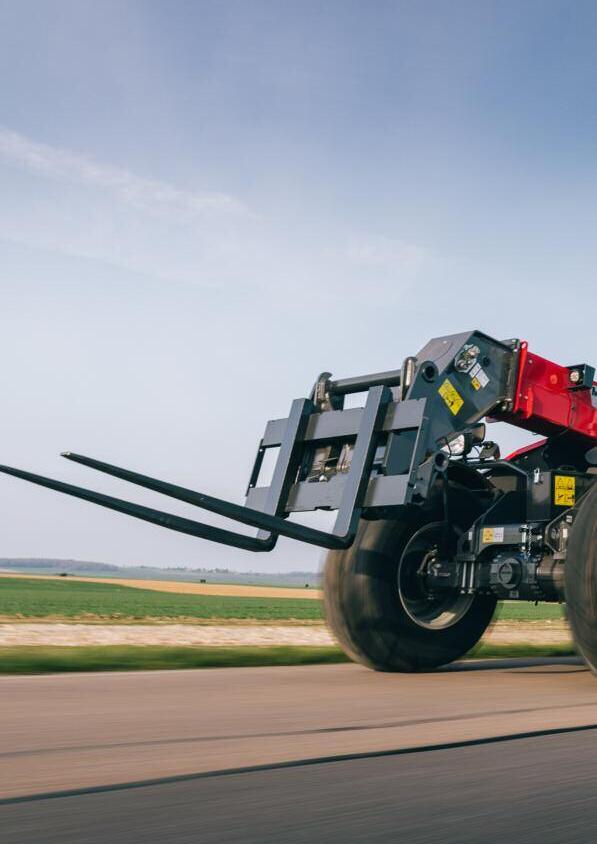
from 6.5m up to 7.5m and lift capacities of 3 4t up to 4 3t on the MF TH 8043, which can also be equipped with a 3,500 litre capacity bucket
Designed specifically to offer MF TH operators the next level of comfort and control, the completely new cab features a more rounded, asymmetric structure with easy access through a wider opening door Operators now sit comfortably on the new standard air-suspended seat A heated seat option, coming from MF tractors, responds automatically to the severity of the bumps and has automatic height and weight adjustment
The spacious cab is now much quieter at all operating speeds and conditions, including when the windows are open. Measurements show a significant reduction of 1 5dBA on road and up to 2-3dBA during loading operations, along with a reduced noise intensity and tone
There is superb visibility thanks to the special curved cab design and a new, lower profile engine bonnet shape
maintains a completely unobstructed view to the rear three quarter right-hand side New mirrors, mounted at a higher position, provide a better view of what’s behind, while a removeable floor mat reduces noise and is easy to clean
Options include an integral cool box, electric right-hand mirror and a lateral wiper, to further improve the view to the side and mirrors
All models have the exclusive left-hand MF Power Control lever as standard Exactly the same as that used on all MF tractors, it sits conveniently just under the steering wheel and with fingertip-operation performs three functions: Shuttle forwards and backwards, shift hydrostatic speed ranges up and down and select neutral. This leaves the right hand free to control loading operations, while a flick of a finger on the left hand controls the transmission
A new standard 5” colour terminal clearly displays operating information and can be used to select the steering modes, which include a new semi-crab setting An intuitive menu makes it easy to navigate between settings, while the view from the optional rear camera, with safety guidelines, automatically appears when reverse is selected
Further functions are available from optional 7” display terminal, which allows operators to select the steering mode and the hydraulic flow or sequence from the screen, as well as view detailed job management information for tasks and operators It also comes with a Bluetooth connection and an integral phone mic installed on the dash, along with integrated radio and music settings.
Specifically developed for the MF TH Series, the new ergonomic
multi-function joystick delivers smooth control, requiring at least 20% less effort than its predecessor, which enables effortless and precise operation of the hydraulics and transmission
A simple three-position rocker on the rear face is used to select forward, reverse and neutral These replicate the same functions on the MF Power Control lever, providing a choice of how to change direction and control the transmission
A new bucket shake option, controlled by a button on the joystick, helps to quickly fill and empty the bucket The shake response is linked to the joystick movement, allowing operators to control the amount of action and its time.
Just behind the joystick, on the console, is the MF TH control pad with
clear and simple buttons use to navigate the new display screen Radio and telephone volume control is also found here when 7” terminal option selected To the right of the joystick is the new hand throttle Introduced to fulfil customer demand, this also plays a big role in the transmission control
A new armrest-mounted joystick o ption allows users to take full advantage of the extra comfort from the suspended seat It can angled to suit operators’ preferences
This latest generation MF TH Series introduces a completely new way to operate the hydrostatic transmission, which is fitted to all models. Now, with the addition of the new hand throttle, operators can set the desired engine speed and then use the pedal to vary the travel speed of the telehandler
Enhanced control is offered by the

by Chris McCullough
Sheep
Beltex
Kevin Buckle, Cumbria
Berrichon
Clarke Lamont, Dumfries
Bleu Du Maine
Ian McConnell, Dumfries
Blue Texel
Martin Sivill, St Asaph
Bluefaced Leicester/Mules
Derek Hall, Midlothian, (btm right)
Border Leicester
John Mauchlen, Roxboroughshire
Charollais
Russell Gray, Lanark (right)
Dorset Horn & Poll
Sam Driver, Derbyshire
Dutch Spotted
Pamela Parker, Lockerbie
Hampshire Down
Harry Middleditch, Suffolk
Ile de France
Clarke Lamont, Dumfries
Jacob
Lyndon Trumper, Monmouthshire
Kerryhill
Katie Esler, North Somerset
Lleyn
John Dugdale, North Yorkshire
North Country Cheviot
Tom Matthewson, Midlothian
Minority Breeds
Ernest Bainbridge, North Yorkshire
Rouge de l’Ouest
Ian McConnell, Dumfries
Suffolk
Andrew Wilson, Raphoe
Texel
Henry Gamble, Groomsport
Valais Blacknose
Brian Matthews, Killeigh
Zwartbles
Ally Baird, Dunblane
Interbreed Pairs of Ewe & Ram Lambs,
Shearling Ewes and Rams
John North, North Yorkshire
Interbreed Pairs Championship, Group of Three
Andrew Walton, Northumberland
Interbreed Overall Championships
Brian McTaggart, Castle Douglas (top)
Sheep Young Handlers
Michael Graham, Antrim
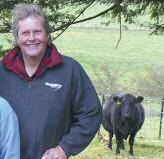
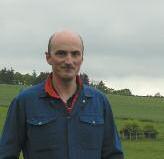
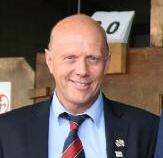
Adrian Caldwell, Co Tyrone
Alan Crockett, Co Tyrone
Alan Longstaff, Co Antrim
Andrew Rankin, Loch Lomond (third)
Brendan Kelly, Co Antrim
Brian Megahey, Co Antrim
Bryan Wilson, Co Antrim
Colin Crowe, Westmeath
David Jones, Co Antrim
David O’Neill, Co Tyrone
Fionan Butler, Co Antrim
Ian Montgomery, Co Antrim
Jack Robinson, Co. Londonderry
John Ivor Davis, Wales
Klaus Keifer, France
Peter Webber, Devon
Richard Schofield, North Yorkshire
Robin Kennedy, Co Antrim
Seamus Kelly, Co Antrim
Tom Dunne, Wicklow
Tom Perry, Co Tyrone
Wallace Boyd, Lanark (bottom page)
William Jones, Co Antrim
Large White, Landrace, Pork Pigs, Interbreed Championships, Traditional Breeds, Pairs, Interbreed Championships
Andrew Warriner, York
Pig Pairs
Cyril Millar, Coleraine
Pig Young Handler
Pat McIver, Cossgar
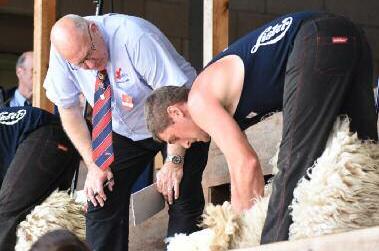
Poultry, Pigeons, Eggs
Turkey, Waterfowl, Modern Game, Old English Game, Hard Feather, Bantams Large
Leon Smith, Norfolk
True Bantams
Andy Marment, Cornwall
Soft Feather (Light Large & Bantam)
Ian Allonby, Cumbria
Soft Feather (Heavy Large & Bantam)
Kevin Dowrick, Cornwall
Pigeons
Cyril Beattie, Tandragee
Shelled Eggs & Championship, Children’s Decorated Eggs
Colin Clarke, Norfolk
Beef Cattle
Aberdeen Angus
Brian Clarke, Norfolk
Hereford
PJ Budler, Texas
Charolais
Andrew Hornall, Stirling
Simmental
David Lowry, Lanark (right)
Limousin
Mark Quick, Devon
British Blonde
William Laird, Fife (far right)
British Blue
Andrew Haste, Beaworthy
Salers
Iain Livesey, Melrose
Commercial
Dafydd Lewis, Llanwrda
Beef Shorthorn
Bobby Landers, Wigtownshire
Dexter
Mary Kay, Dorset
Irish Moiled
Derek Steen, Dumfries
Junior Championship and Champion of Champions
Mike Durno, Ballindalloch (top right)
Beef Group of 5 Native and Continental & Exhibitor Bred Pairs
Chris Pennie, Powys
Interbreed Performance Bulls & Heifers & Interbreed Stock Judging
Albert De Cogan, Co Cork
Beef Pairs, Group Championships
William Smith, Co Meath
Beef Young Handlers
Marie Louise Ryan, Thurles
Beef Presentation Award
Alex Woods, Banbridge
Renton Ledbetter, Cupar
Dairy Cattle
Dairy Cattle
Iwan Morgan, Carmarthenshire
Dairy Young Handlers
Iwan Morgan, Carmarthenshire
Dairy Presentation Award
Alex Woods, Banbridge
Renton Ledbetter, Cupar
Trade Stands
Mark Stoddart, Yorkshire Agricultural Society
Nicola Weir, BBC
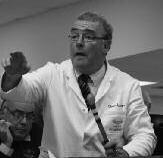

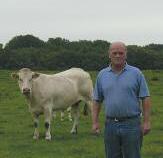
Wed 11th May – Sat 14th May
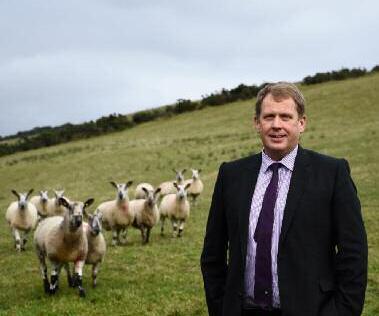
Continued from page 49
Dynamic Drive, which changes the shuttle aggressiveness and throttle response This enables operators to choose how quickly or slowly the transmission responds to match the application or conditions.
Other improvements to the unique four-range transmission enable it to respond more smoothly and precisely to millimetre accuracy
A powerful load-sensing hydraulic system supplies up to 190 litres/min on the 135hp machines and 100 litres/min for the 100hp models, with proportional electro-hydraulic control on all functions delivering optimum accuracy and productivity This delivers superb lifting performance even at low engine speeds, with Massey Ferguson’s SHS (Smart Handling System) allowing operators to set the maximum flow for smooth and accurate operation
Cushion Retract ensures a smoother action and extends the life of the components. An additional electric control can be specified to provide a fourth and fifth service to operate demanding implements, such as straw choppers and feeding buckets



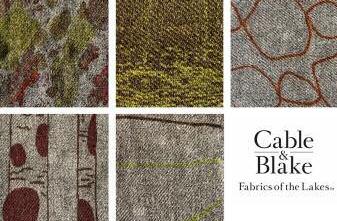
Izzie Castle, a newly graduated Printed Textiles student from Glasgow School of Art, has created a series of printed fabrics for Cable & Blake, which bring a contemporary edge to the big skies and broad landscapes of the Lake District Izzie said, "I was so delighted to be asked to communicate the spirit and ethos of Cable & Blake
through these series of designs entitled 'Cumbrian Landscapes'".
Cable & Blake is the only fabric producer to digitally print on Herdwick wool and as Creative Director Rachel Cabble explains: "introducing Izzie's designs has expanded the collection and added a modern twist to our sustainable product "
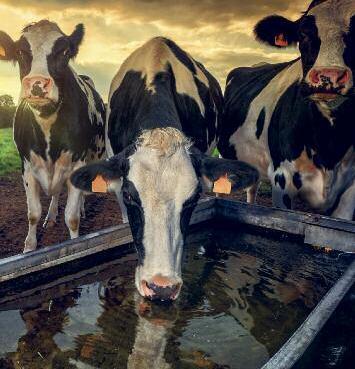


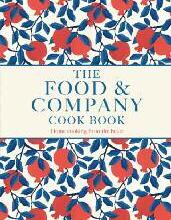
Tony Robbins is a world renown life and business coach, who has worked with 50M people so far The book is a collection of the world's top medical minds and their latest research, the advancements in precision medicine in improving the quality of our life and even extend the length of our life. Robbins had his own health challenges and experienced firsthand, how new regenerative technology not only helped heal, but made him stronger than ever before at the age of 62! He adds miracle stories and empowering examples of humans who show us what is possible, no matter our age Even small changes in our lifestyle can have a huge impact on our quality of life, how long we live and can even modify our epigenetic pattern Good food, exercise, a healthy weight, not

The Food & Company Cook Book is all about real honest cooking, drawing on years of experience in catering and cookery demonstrations alongside a great appreciation for local produce in the authors' native Cumbria Joan Gate and Margaret Brough are sisters and farmer's daughters who have been in business together for over 30 years Their skills, knowledge and love of food all come together in these pages, sharing tried and tested recipes alongside stories of their journey
Each chapter of recipes has a distinct theme, from California Dreaming to Christmas on a Plate and of course –A Taste of Cumbria. The recipes themselves include meals to cook for big family gatherings, sweet treats to enjoy at coffee mornings with friends, simple yet stunning canapés and seasonal ideas to take you right through the year in
smoking, only moderate intake of alcohol or avoiding stress can make a huge difference Less obvious: A healthy mindset and attitude to life, sufficient sleep (between 7 and 8 hours), avoiding night shifts, exposure to cold, proper breathing or not eating for a certain amount of time (intermittent fasting). This 700-page-tome is a book for life and should be in anybody's library, who wishes to improve their health, energy and vitality It comes with a website, which will be kept updated as new information and discoveries come in
Tony Robbins (2022): Life Force. How New Breakthroughs in Precision Medicine Can Transform the Quality of Your Life & Those You Love, Simon & Schuster, London, Hardback £ 25
The author is neurosurgeon and CNN chief medical correspondent His book is not about improving IQ, it is more about how to create new brain cells and making the ones you have work more efficiently. It is a guide to keeping your brain young, healthy and sharp. His message: Cognitive decline is not inevitable as we get older. It is liberating to find out: we can do something for a healthy and fit brain at any age and it does not cost the world Gupta explains how our brains work and why we can rewire them He shows practical strategies, how to protect and enhance the health of our brain and why it is important Why it is beneficial to exercise, have a sense of purpose,
food. There's also a section dedicated to 'Ladies Who Lunch' (or anyone keen on cooking up a storm!) for three course dinners complete with suggested wine pairings
From farmer's daughters to renowned outside caterers in Cumbria, the pair have been in business together for three decades and for the last 15 of those they have run ever-popular cookery demonstrations Beginning with JM Caterers in 1991 and moving on to Food & Company in 2005, Joan and Margaret have a regular venue at the beautiful Cumbrian manor Mirehouse, near Keswick, with returning customers and fully booked events throughout the year. This, their first book – is a 192 page hardback and retails at £22. www foodandcompany co uk as well as Waterstones (online and in stores) and www.mezepublishing.co.uk.

enough sleep, good food and socialize more in person And why you better stop multitasking and don't take supplements He advocates to lead a rich, active, dynamic and complex life There is also a 12-week-programme with practical strategies, easily incorporated into daily life Gupta also addresses various brain diseases, signs and symptoms and how to care for a partner in cognitive decline. As life expectancy is growing and brain issues increase, Sanjay Gupta delivers a very helpful book with the latest insights.
Sanjay Gupta (2020): Keep Sharp: How To Build a Better Brain at Any Age. Headline Publishing Group, London, Paperback £ 14.99
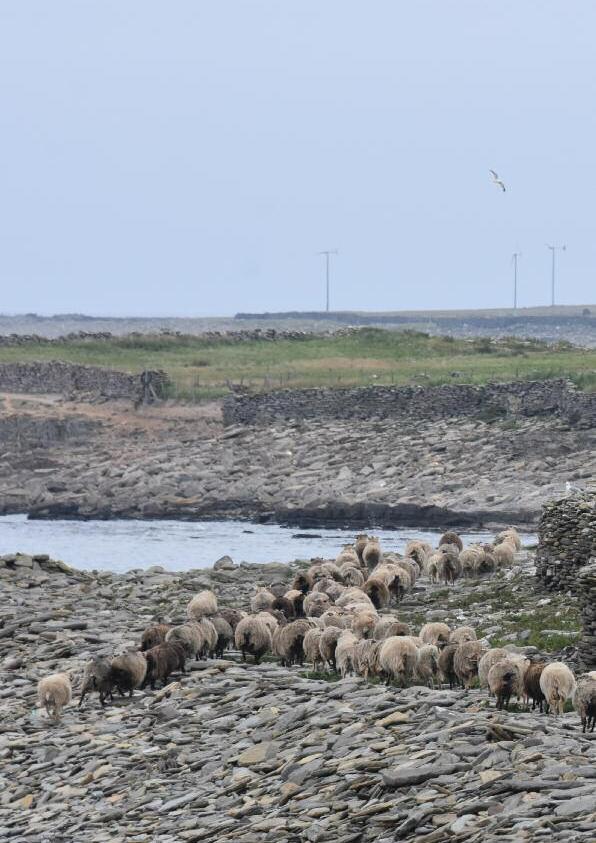
by Eilidh MacPherson
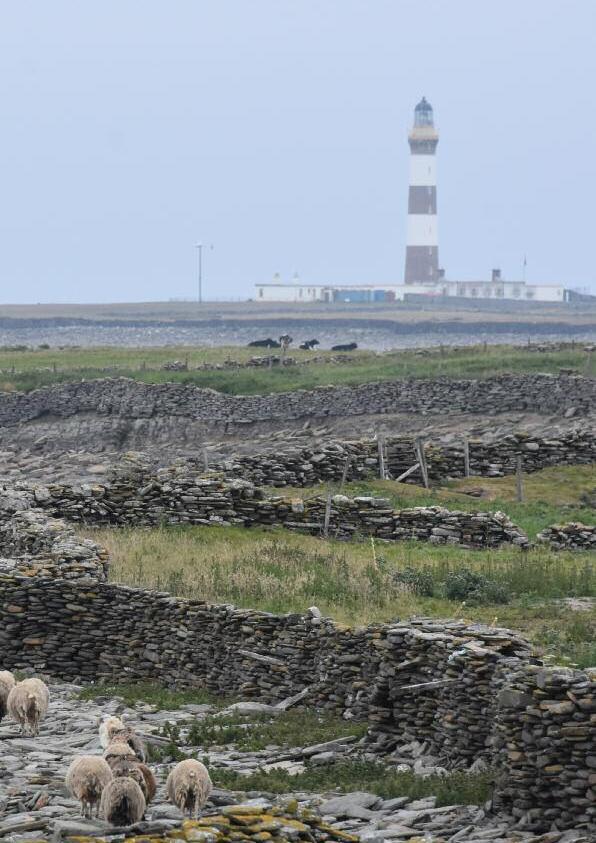
Punding and sheep shearing on North Ronaldsay was the highlight of our Orcadian adventure
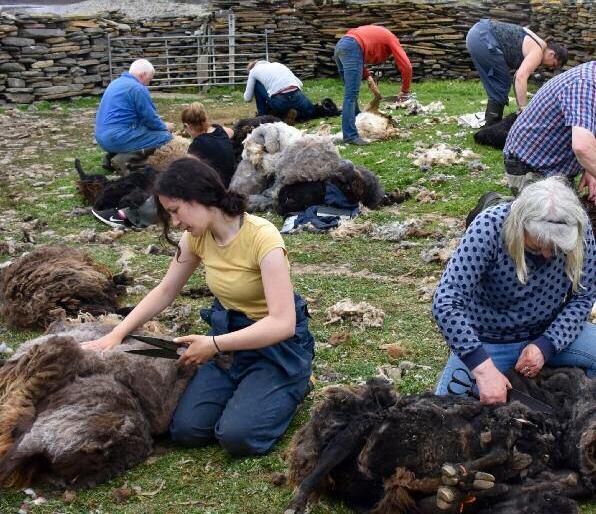
The island of North Ronaldsay (with particular interest in the North Ronaldsay Sheep) – has always been on my bucket list. So last summer with warmer climes definitely off the ‘getaway’ itinerary, it was Orkney bound for us.
When enquiring re the date of the sheep shearing on North Ronaldsay, back in February last year, I was astounded when the Clerk of the North Ronaldsay Sheep Court replied “We will be shearing on the 24th of July ”
“How can you be so accurate?” I retorted Having been an island sheep shearing contractor (on Skye) for six years, employing Kiwis, I had insider knowledge that so many variables come into account, especially the weather!
“We go by the Spring tides and high tides so the sheep have less chance of escaping,” explained the Clerk, Michael Scott, who is a solicitor for the Orkney
Council and flies daily to the ‘Mainland ’ Ferries and flights booked Roll on July!
After a couple of days touring the Orkney Mainland and seeing the sights: the Italian Chapel, Churchill Barriers, standing stones and a Neolithic dig, to name but a few, Richard and I took an 8 seater Loganair Inter Island flight –destination North Ronaldsay – the northernmost island in the Orkney archipelago A seventeen minute flight, which cost about £15 return saw us fly over calm aqua coloured waters and the islands of Stronsay and aptly named Sanday, before landing
With limited holiday accommodation on the island, we had booked into the Bird Observatory, www.nrbo.org.uk Luckily for us one of the staff had been on the same flight and drove us to the door The guesthouse accommodation was inexpensive considering the
generous and tasty breakfasts and evening meals, which set us up each day – fully recommended
An hour after our arrival we were piled into a minibus driven by ornithologist and owner of the Bird Observatory, Alison Duncan. Her son Gavin, a newly qualified doctor and daughter Heather, local Councillor and several seasonal staff made up the team
We were off punding – the North Ronaldsay term for gathering sheep into a fank, sheep pens or the pund – a true busman’s holiday!
We joined another dozen or so locals at one of the nine punds, which are situated close to the coast, all ready for a days shearing With not a dog in sight, the sheep took off along the shoreline of the seaward side of the dyke (photograph on pages 46 & 47) at a rate of knots A group of youths were positioned just around the corner at a
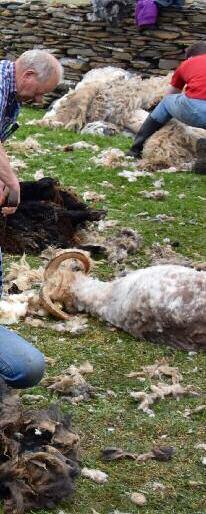
narrow gap between high tide and the drystane wall
The flock then came hurtling back in our direction, amazingly agile over the rocky terrain. We, along with the Bird Observatory staff, were crouched behind a line of metal sheep hurdles, which reached from the pund opening down into the sea The bulk of the multi-coloured drove, submitted and headed into the enclosure, while four of their cohorts made a bid for freedom Three jumped the hurdles; one whacking a blonde twitcher right in the face en route and the fourth was a swimmer
I must admit they were penned much easier than we had anticipated An elderly gentleman stated, “That is the best punding I have seen in my 85 years!”
North Ronaldsay Sheep are listed on the 2021–2022 Rare Breeds Survival
Trust watch list The breed is seen as a priority, with fewer than 600 registered breeding females in the UK, they are in danger of extinction
Stepping back in history – as the kelping industry (the production of soda ash from seaweed) dwindled and became uneconomical, a dry stane dyke was built encircling the island to keep the sheep out on the foreshore to protect the crofting land on the inside. The 12 mile dyke, measuring on average, 6 feet high, which is now Grade A listed by Historic Scotland, was completed in 1832
Over time the flock evolved to live almost entirely on seaweed – they are one of few mammals to do this This diet has caused a variety of adaptations in the sheep's digestive system These sheep have to extract the trace element copper far more efficiently than other breeds as their diet has a limited supply of copper, resulting in them being susceptible to copper toxicity, if fed on a grass diet, as copper is toxic to sheep in high quantities Grazing habits have also changed to suit the sheep's environment To reduce the chance of being stranded by an incoming tide, they graze at low tide and then ruminate at high tide
In 1839, after the wall was erected, the North Ronaldsay Sheep Court was created. A group of eleven appointed islanders were responsible for the maintenance of the wall, the health of the sheep flock and recording ownership of the sheep Today, the Sheep Court remains the regulatory body responsible for organising ownership of the sheep, but all crofters have a say Nowadays 1602 ewes and followers roam the foreshores of North Ronaldsay (tot 4806 sheep 2021 census)
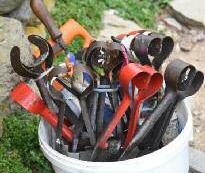
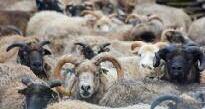


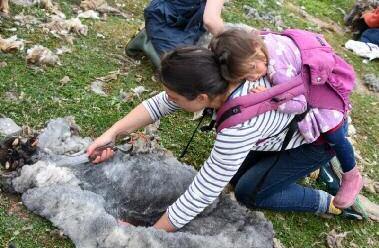
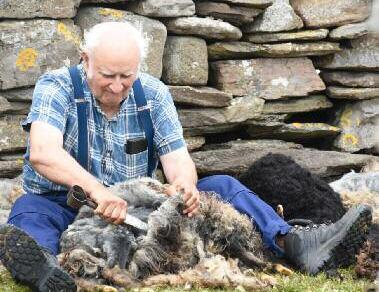
Prior to lambing the ewes are brought onto the crofts to lamb and back out to join the tups and wethers for the rest of the year
As the islanders’ forebears did before them, they set about hand shearing the punded sheep Probably the only difference from days gone by would be the plastic ear tags identifying each crofter ’ s lot They all bound the legs with twine, but had varying techniques for de-fleecing their flocks Local primary teacher Helga Scott managed to clip with her daughter on her back The click of the shears and some craic back and forth whiled the time away.
Jane Donnelly stood in the catching pen selecting each crofter ’ s sheep when they were near completion of their last. Jane was instrumental in establishing the woollen mill, which is housed in the lighthouse buildings She travelled to Belfast Mini Mills, Prince Edward Island, Canada, to see a specialised de-hairing and wool processing plant in action On her return, A Yarn From North Ronaldsay was born and now the complete clip is handled on the island In addition to the spinning machines, the mill also has a felting press and the output from this has been used for a range of products, from rugs and wall hangings to linings for baskets
Richard and I both lent a hand and shore a few sheep, Bowen style, no twine involved!
Day two saw us driven to a pund at the northern tip of the island by the
lighthouse. Reinforcements for gathering included a JCB and a quad bike! This time the sheep scattered in all directions and a collie or two would have been a welcome sight But after an hour or so and a few tactical moves around 150 were captured
By early afternoon hunger was setting in and we succumbed to the lure of the newly opened cafe in the lighthouse – The Lighthouse Cafe Richard raved about his North Ronaldsay mutton pie for days The high iodine content from the seaweed gives the meat a gamey flavour
As we ate Billy Muir, pictured above, came in dressed as a light house keeper. He had quickly changed from his shearing garb to give some tourists a tour of the lighthouse! He had been the keeper for almost 30 years until it was automated in 1998 Like many other islanders he wears many hats
Since our visit The North Ronaldsay Trust has been awarded £102,831 41 from the Island Communities Fund towards the creation and building of a Meat Larder on the island It will allow the island to process the sheep at source (this is currently done elsewhere) and sell high-end quality meat cuts directly The project will create jobs and increase the value, as well as the status, of the much sought-after native North Ronaldsay mutton
We thoroughly enjoyed our visit to and adventures on North Ronaldsay. Next stop the island of Rousay to visit our old neighbours Jean and David Gibon, who moved from Furmiston

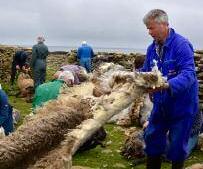
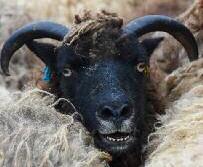
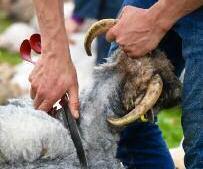
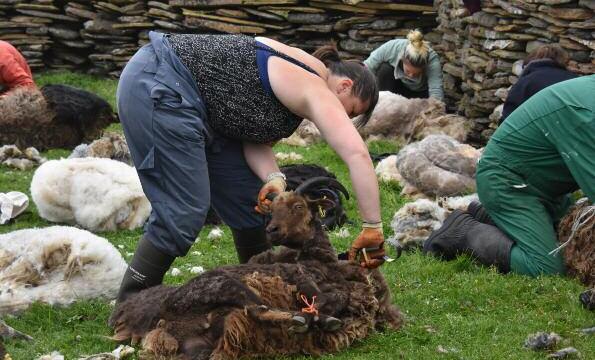
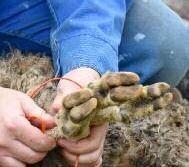
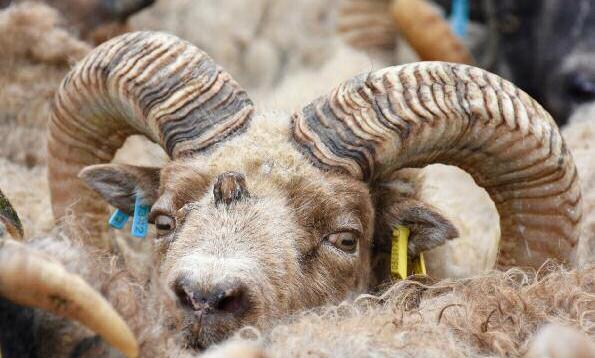


Every year at the beginning of summer, 500 cattle, including 200 dairy cows, make their way up to Engstligenalp in the Bernese Oberland – it is the steepest Alpine drive in Europe.
by Petra Jacob
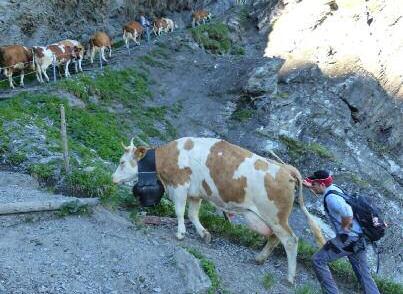
Five o 'clock in the morning, cowbells ring in the small hamlet of Adelboden, at the foot of the mountains. The majority of the animals have arrived the evening before and graze on a field The Engstligenalp has lush grazing and around 2000 m it is Europe's highest plateau, the journey up to the summer pasture is the steepest alpine drive in Europe.
The climb can be very exhausting, therefore calves and older cows are excluded from the journey They used to transport them via public cable car “There was only room for one cow at a time,”explains a farmer. He stands a few hundred meters down the cable car station over the parking lot in front of a newly purpose-built cable car He is in the process of loading two of his cows into a modern container, with room “For nine cattle or 6t of material," he explains This cable car was completed in 2019 and now transports around 200 of the cows up the mountain each season. The others will be on foot, they will need around 2 hours for the 600m in altitude – the cable car takes only 10 minutes
65% of the total investment of Swiss Francs( CHF) 1 8M (GBP 1 68M) was paid through public funds, the rest by the Engstligenalp Alpine Cooperative. Two thirds of the time the cable car is used for the transporting material, for example during skiing season The farmer pays CHF 40 (GBP £32) per Tonne to the Cooperative for transporting his livestock up the mountain
Most of the cattle don't have it that comfortable The ascent is a narrow, steep mountain hiking trail, the scenery is spectacular. Sometimes there are
steps to climb, at times knee-high, even strenuous for a hiker To see cows with much shorter legs to conquer these steps is impressive. The experienced ones, the ones who have done this before, lead the way. They pause at regular intervals, look back into the valley, then continue with a lot of commitment They know what lies ahead: a high, sunny plateau with lush mountain meadows, rich in flowers, herbs and mountain streams. It is a beautiful sight The grazing surrounded by snow-capped mountains, dotted with rustic mountain huts and cows refreshing themselves in the mountain streams. There is grazing for around 500 animals for ten weeks, including 200 dairy cows and 15 goats –the rest are calves
The cattle drive is quite a spectacle, cows and people are dressed up Women in dresses, men in blue mountain shirts. Many hikers accompany the animals on their way up the mountains Some take the cable car, the first one runs at 5 in the morning A lot of the onlookers don't have any connection with agriculture anymore. Therefore at the beginning of the trail posters are put up, explaining how to stay safe
The last part of the path is the most difficult It is very narrow, steep and rocky, cows and men should be comfortable with heights. Safely up the mountain, there are many onlookers; alp horn players, there is yodeling, singing, a man waving a large Swiss flag Many mountain huts are places to have a drink and a bite to eat. There is a 5 km long circular trail round the plateau which, even made accessible for wheelchair users The cows here graze freely without fences Tourist brochures advertise, that visitors here are able to
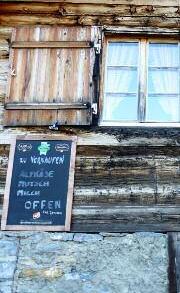
experience "animals up close." In eason the cable car brings around 800 visitors per day up the mountain And there are the many who come on foot The Alp is therefore not only for cows, it is a tourist magnet as well.
Hidden behind rocks and green hills, is Rüeblihütte, a typical mountain hut It offers bed and breakfast The bed is on a mattress under the roof and above the cow shed The place is run by Martha and Ueli Grossen, it is their 35th Alpine summer, they say. During winter Martha is a ski instructor, her husband works in a sports shop in the valley While they work in winter jobs, they rent the Rüeblihütte out to another couple, who take over the winter operation. Son Markus is in charge of the 17-ha valley farm in Frutigen, where in summer he makes hay for winter fodder In winter Markus also works as ski instructor In summer all their cattle are on Engstligenalp, they have around 50, 27 are dairy cows.
Typical for this area is a three-stage farming operation, explains Markus, who regularly comes to the Alp to help his parents. Till the beginning of April, the cattle are in the barn, that is followed by one month grazing around the farm. For the last part their cows are brought to grazing at slightly higher altitudes at the foothills of the Alps “To the make the cattle mountain-proof,” explains Martha. “Just like people, cows have to train to be fit for the mountains " The right cow breed is also important, they say They prefer Simmental and Swiss Fleckvieh
“As a mountain farmer, you don't bring a high-performance cow to the farm anyway, " admits son Markus, who also serves as president of the

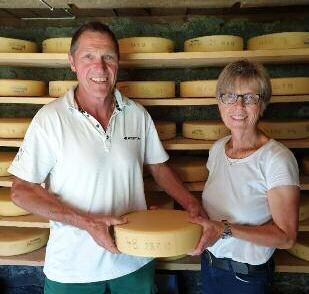
Engstligenalp Alpine Cooperative.
To have their cows in summer in the mountains relieves the farmer, because instead of feeding his cattle, he can make hay from the grassland in the valley Yes, cows do burn more energy in the mountains and thus give less milk, Markus says, still they give on average 20 to 30l of milk per day On the other hand, the milk has a fat content of 4 5%, with 3 3% protein and produce delicious mountain cheese. This can almost entirely be sold from their mountain hut on Engstligenalp "I have regular customers, they come three times in the summer and get cheese," says Martha Cheese she can't sell is stored in a cave down at their valley farm and is brought back to the Alp the next season and sold as more mature cheese "People just like to buy their cheese on the Alp," admits Martha The Grossen family produces around 1t of cheese every year and sells it for between 18 and 24 Franken (GBP £14.21 and £18.95) per kilogram.
A great experience is spending the night at Rüeblihütte On a red and white checkered tablecloth, Martha has placed products from the farm: fresh butter, smoked beef, beef salami and three different mountain cheeses (young, one year old and two year old) Through the window, the curtains are red and white checkered as well, their cows trot from the milking barn back onto the lush pasture. From the breakfast room one can look into the cheesery and watch Martha and Ueli making cheese A lot of time is spent cleaning
The first hikers arrive around ten and ask for drinks, cheese with bread and sit outside under the sun umbrellas On a sunny day it will be very busy At
quarter past five, the last guests leave
"After the last cable car has left for the valley, it is a different world up here," admits Martha. The valley disappears under a blanket of fog, hundreds of mountain peaks peek through the fluffy clouds and it feels like to be on the roof of the world “And I remember, why I am so happy here And why I get itchy feet in the spring to get back into the mountains.”
At the end of the season, in September, however, she is tired, she admits She will have produced 1 t of cheese and welcomed thousands of guests. Son Markus will load the unsold cheese onto a trailer and drive it with a tiny tractor to the cable car station On his journey he will meet many hikers, they will greet, praise and photograph him and the cheese wheels and when loading them into the cable car even give him a helping hand.
Markus is grateful for being a mountain farmer, “Swiss people like us, we are highly regarded and we also get a lot of support from the state.” He feels for other farmers, who have it much harder than him. Still, he is not sure, if he wants to have dairy cows for the rest of his life," he admits "Many people think of our life as being very romantic, they are losing touch with farming. There is a high demand for milk, still, the milk price is in no relation to the cost of production " It is different with cheese “You add value to the milk, you can't count the working hours though " Markus lifts his last cheese wheel into the gondola. “Money is not everything, as long my parents are still fit enough, we will continue,” he says and floats with 700 kg of his cheese down the mountain


